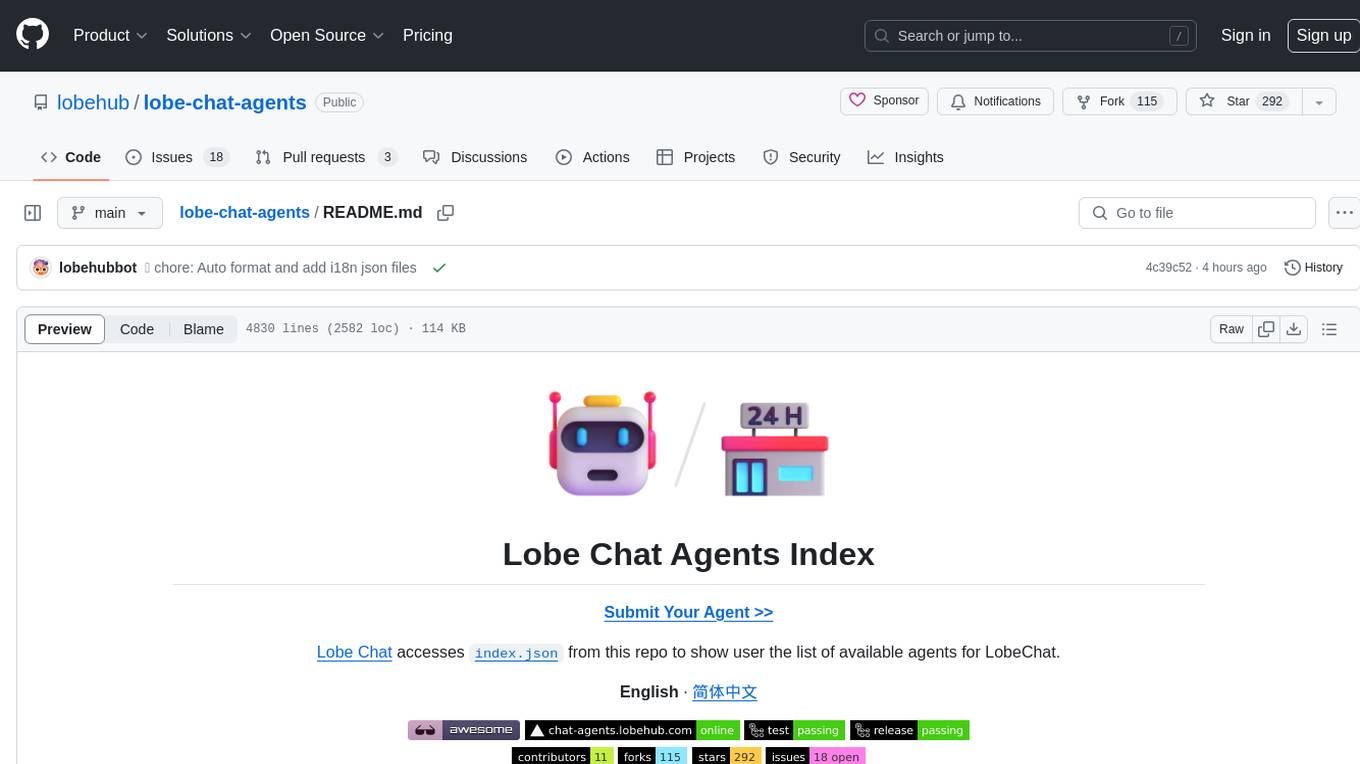
video2blog
视频转图文 AI 跨平台客户端(win mac linux) electron vite vue3 sqlite3 naive-ui
Stars: 58
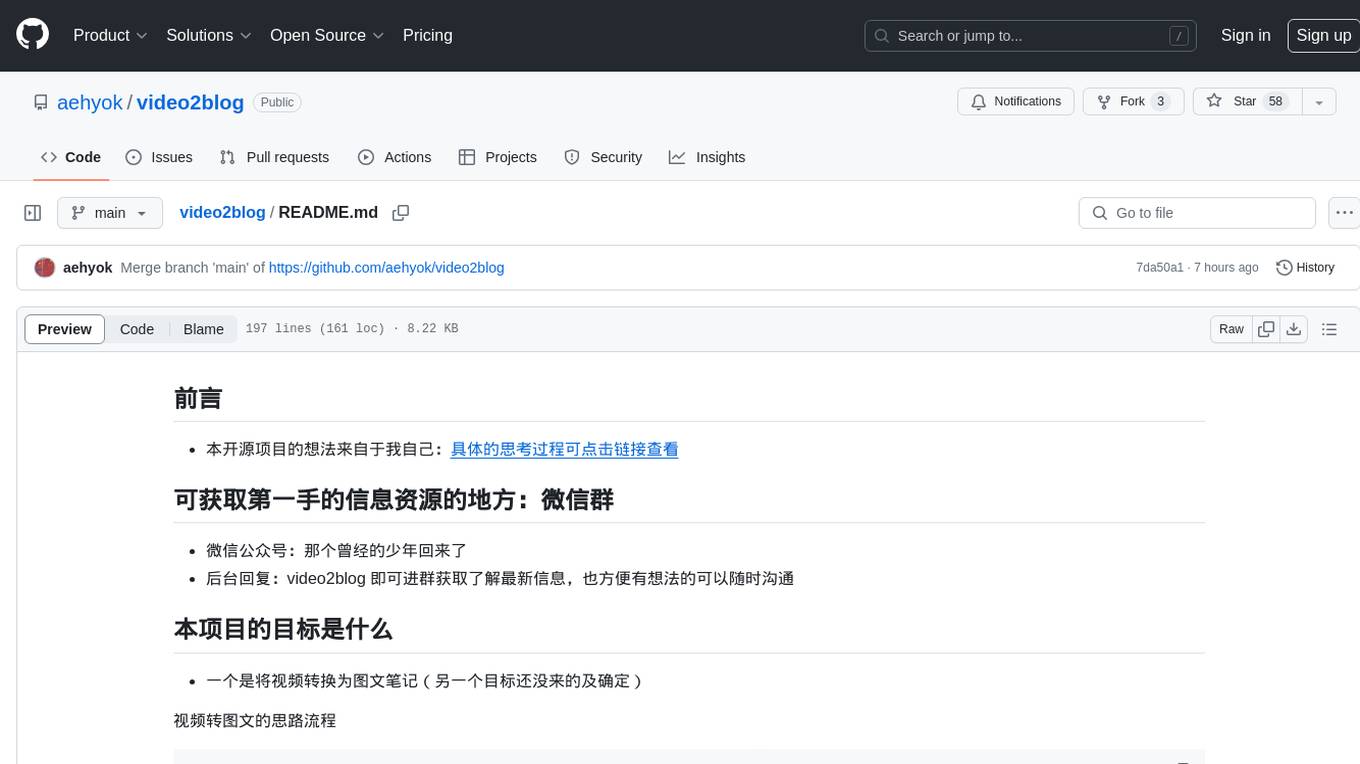
video2blog is an open-source project aimed at converting videos into textual notes. The tool follows a process of extracting video information using yt-dlp, downloading the video, downloading subtitles if available, translating subtitles if not in Chinese, generating Chinese subtitles using whisper if no subtitles exist, converting subtitles to articles using gemini, and manually inserting images from the video into the article. The tool provides a solution for creating blog content from video resources, enhancing accessibility and content creation efficiency.
README:
- 本开源项目的想法来自于我自己:具体的思考过程可点击链接查看
- 微信公众号:那个曾经的少年回来了
- 后台回复:video2blog 即可进群获取了解最新信息,也方便有想法的可以随时沟通
- 一个是将视频转换为图文笔记(另一个目标还没来的及确定)
视频转图文的思路流程
1、输入视频url之后
2、先通过yt-dlp解析视频url获取视频信息
3、通过yt-dlp下载视频
4、如果存在字幕,则直接进行下载
5、可能是非中文字幕,则需要进行翻译字幕
6、如果不存在字幕,则通过whisper来生成字幕文件,并翻译为中文
7、然后通过gemini将字幕转换为文章。并将视频中的图片进行提取,手动插入到文章中
- node和npm的版本在这附近应该都可以跑起来
node -v //20.11.0
npm -v //10.2.4
- python和pip运行版本
python3 -v //3.11.2
pip3 -v //24.0
- 安装项目依赖
npm i
- 本地window下运行
npm run start-win
- 本地mac下运行
npm run start-mac
主要在于win下命令行中中文乱码,mac下不会出现这个问题,于是使用 chcp 65001 命令来解决这个问题
-
通过git仓库打tag标签来触发编译 github action workflow
-
其中python脚本
在window开发环境下打包,会在/command/win目录下生成exe文件
pyinstaller --onefile RemoveDuplicateImages.py -y --distpath ../command/win -n executename.exe(executename)
如何安装pyinstaller呢
pip install pyinstaller
- 在python/xxxxx目录下 可进行安装依赖
pip3 install -r requirements.txt
- 如何将依赖安装到 requirements.txt中
pip3 install xxx
pip3 freeze > requirements.txt
如何单独执行去重命令 window下 python main.py H:\github\electron-vite-tools\command\2024-05-10-16-29-38\000000133 30
// 第一个版本
现在你作为一个科技博主,请先精读上面的字幕,然后根据字幕内容再进行分段,分的段落不要太多,尽量保持在4到8段左右,分段后要对分段内容进行整理,注意一定不需要总结也不要进行删减内容,只是进行整理和微调,并标记字幕时间的区间
//第二个版本
现在你作为一个科技博主,请先精读上面的字幕,然后直接对上面的字幕进行整理成一篇文章进行输出,记住一定一定不要删减任何内容,也不要进行总结。对输出的文章增加目录功能,而且目录标题一定一定要精简,并且在目录上添加字幕时间区间,目录最多4到8个,不能再多。并且再次提醒你,目录下的内容不能进行删减和总结哟
//第三个版本
现在你作为一个科技博主,请先精读上面的字幕,然后直接对上面的字幕进行整理成一篇文章进行输出,记住一定一定不要删减任何内容,也不要进行总结。对输出的文章增加目录功能,而且目录标题一定一定要精简,并且在目录上添加字幕时间区间,目录最多4到8个,一定一定不能再多了。并且再次提醒你,目录下的所有内容不能进行删减和总结哟,后半段的内容也不能进行偷工减料。
将上述输出的内容最终转换为Quill 富文本编辑器的Delta的JSON格式。
//第四个版本
现在你作为一个科技博主,请先精读上面的字幕,然后直接对上面的字幕进行整理成一篇文章进行输出,记住一定一定不要删减任何内容,也不要进行总结。对输出的文章增加目录功能,而且目录标题一定一定要精简,并且在目录上添加字幕时间区间,目录最多4到8个,一定一定不能再多了。并且再次提醒你,目录下的所有内容不能进行删减和总结哟,后半段的内容也不能进行偷工减料。将上述输出的内容最终转换为markdown格式,目录上添加##,目录下的内容不做任何处理就行了
- 暂定的终极版本
角色: 你现在作为一个资深的科技博主
任务:
1、精读字幕: 请仔细阅读提供的字幕内容。
2、生成博文: 将字幕内容整理成一篇博文,务必保留所有信息,不做任何删减或总结。
3、创建目录:
目录标题需精简,并包含对应内容的时间区间,时间区间要精确。
目录数量控制在 4-8 个。
目录格式使用 markdown,即在标题前添加 ##。
所有生成的目录后面都要添加时间区间,前言中的目录列表可以不添加时间区间。
4、正文格式:
保留字幕内容的完整性,不做任何删减或总结。要整理成博文内容啊。
无需对正文内容进行 markdown 格式处理。
目标:
生成一篇包含完整字幕内容的博文,并配有清晰、精简的目录,方便读者阅读和导航。开头是前言加上目录,然后后面以目录正文的形式展示剩余内容。
注意:
确保忠实于原始字幕内容,避免信息丢失。
目录应简洁明了,方便读者快速定位所需信息。
优化说明:
在原提示词的基础上,强调了保留所有信息的重要性,避免博文内容被删减。
明确了目录格式的要求,使用 markdown 形式,并限制了目录数量,确保简洁易读。
细化了任务步骤,使指令更清晰易懂。
最终我直接复制markdown内容使用。
---------------------------------
按照这个格式给我输出一个模板我看看
-
ffmpeg
-
参考文档
-
初始化项目
-
主进程和渲染进程间的通信
-
Menu菜单的设置
-
引入node原生模块
-
Electron 获取当前用户data存放目录
-
npm build 报错 node-gyp
-
sqlite3 操作数据库api
-
python 打包成exe
-
electron-build 打包添加静态资源
- https://www.cnblogs.com/mrwh/p/12961446.html?ivk_sa=1024320u 区分开发环境和打包后的环境进行处理
-
electron-builder编译时报错
reason=prebuild-install failed with error (run with env DEBUG=electron-builder to get more information)
error=prebuild-install info begin Prebuild-install version 7.1.2
prebuild-install warn This package does not support N-API version 36
解决的办法是因为sqlite3的版本问题 npm install -E [email protected]
- whisper 模型
//https://www.bilibili.com/read/cv23285680/
//https://blog.csdn.net/a71468293a/article/details/135995878
// 下载模型
model_size_or_path="指定模型位置"
如果不指定下载模型的位置,则下载到默认的路径 C:\Users\Administrator\.cache\whisper
- mac下编译报错(sh: electron-builder: command not found)
npm i electron-builder
-
无法打开“yt-dlp”,因为Apple无法检查其是否包含恶意软件。
- https://www.jb51.net/os/MAC/881275.html
- 系统设置=>隐私与安全性=>往下拉可以看到=>安全性 yt-dlp =>点击允许即可
-
安装poetry 来管理python包
For Tasks:
Click tags to check more tools for each tasksFor Jobs:
Alternative AI tools for video2blog
Similar Open Source Tools

video2blog
video2blog is an open-source project aimed at converting videos into textual notes. The tool follows a process of extracting video information using yt-dlp, downloading the video, downloading subtitles if available, translating subtitles if not in Chinese, generating Chinese subtitles using whisper if no subtitles exist, converting subtitles to articles using gemini, and manually inserting images from the video into the article. The tool provides a solution for creating blog content from video resources, enhancing accessibility and content creation efficiency.
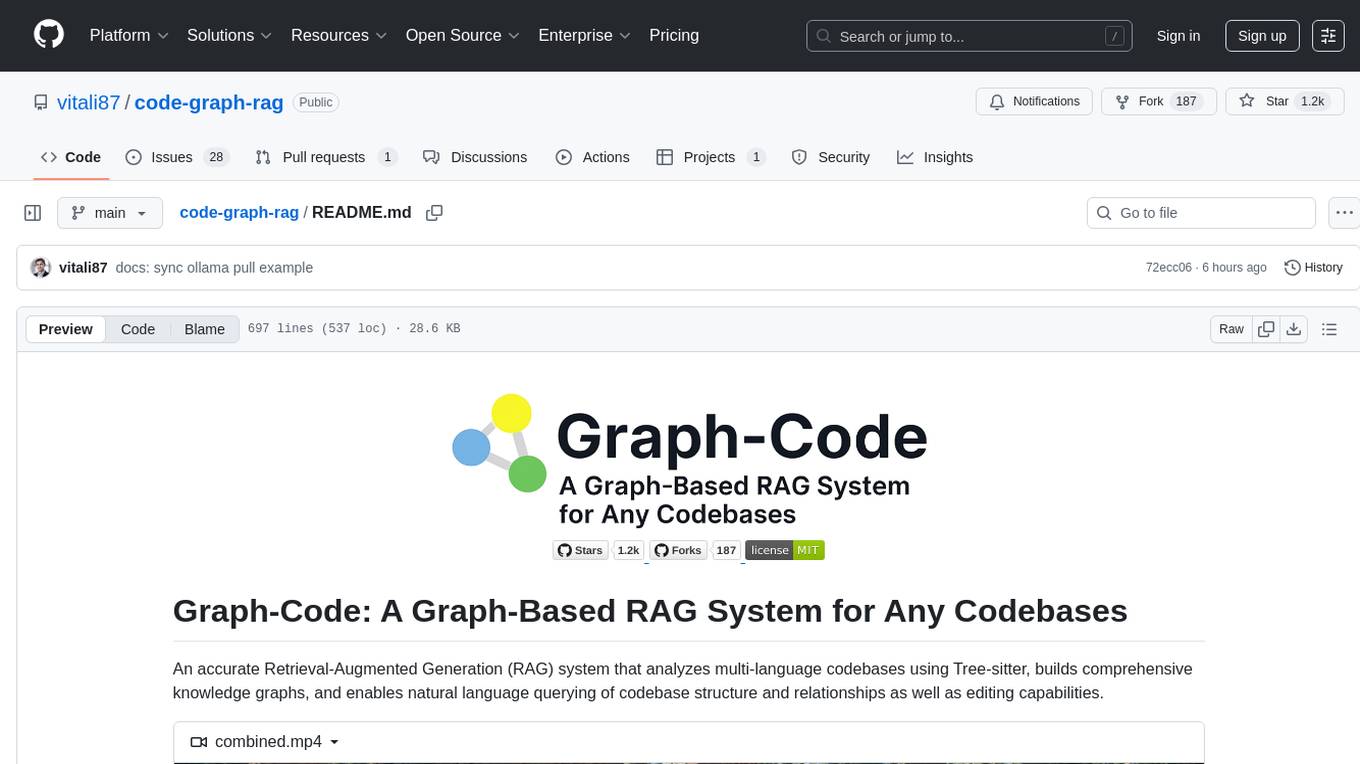
code-graph-rag
Graph-Code is an accurate Retrieval-Augmented Generation (RAG) system that analyzes multi-language codebases using Tree-sitter. It builds comprehensive knowledge graphs, enabling natural language querying of codebase structure and relationships, along with editing capabilities. The system supports various languages, uses Tree-sitter for parsing, Memgraph for storage, and AI models for natural language to Cypher translation. It offers features like code snippet retrieval, advanced file editing, shell command execution, interactive code optimization, reference-guided optimization, dependency analysis, and more. The architecture consists of a multi-language parser and an interactive CLI for querying the knowledge graph.
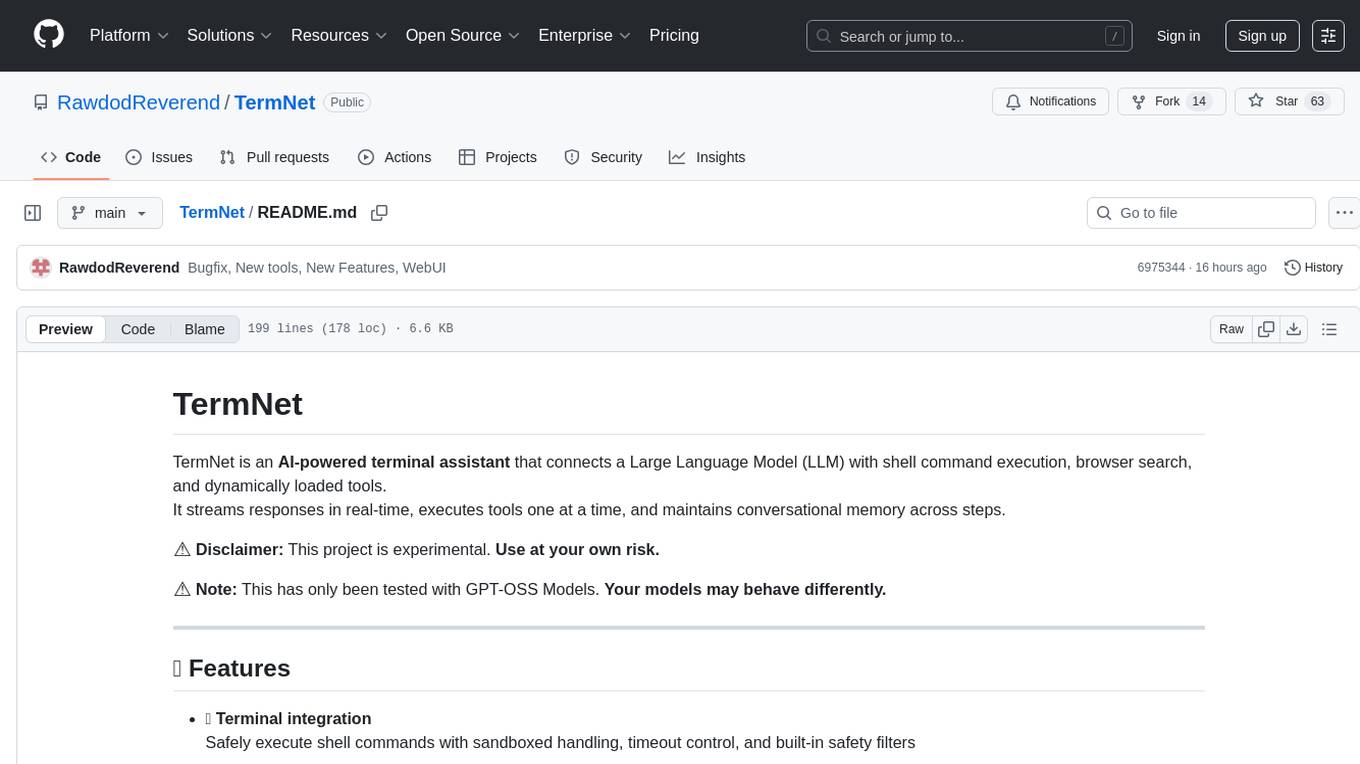
TermNet
TermNet is an AI-powered terminal assistant that connects a Large Language Model (LLM) with shell command execution, browser search, and dynamically loaded tools. It streams responses in real-time, executes tools one at a time, and maintains conversational memory across steps. The project features terminal integration for safe shell command execution, dynamic tool loading without code changes, browser automation powered by Playwright, WebSocket architecture for real-time communication, a memory system to track planning and actions, streaming LLM output integration, a safety layer to block dangerous commands, dual interface options, a notification system, and scratchpad memory for persistent note-taking. The architecture includes a multi-server setup with servers for WebSocket, browser automation, notifications, and web UI. The project structure consists of core backend files, various tools like web browsing and notification management, and servers for browser automation and notifications. Installation requires Python 3.9+, Ollama, and Chromium, with setup steps provided in the README. The tool can be used via the launcher for managing components or directly by starting individual servers. Additional tools can be added by registering them in `toolregistry.json` and implementing them in Python modules. Safety notes highlight the blocking of dangerous commands, allowed risky commands with warnings, and the importance of monitoring tool execution and setting appropriate timeouts.
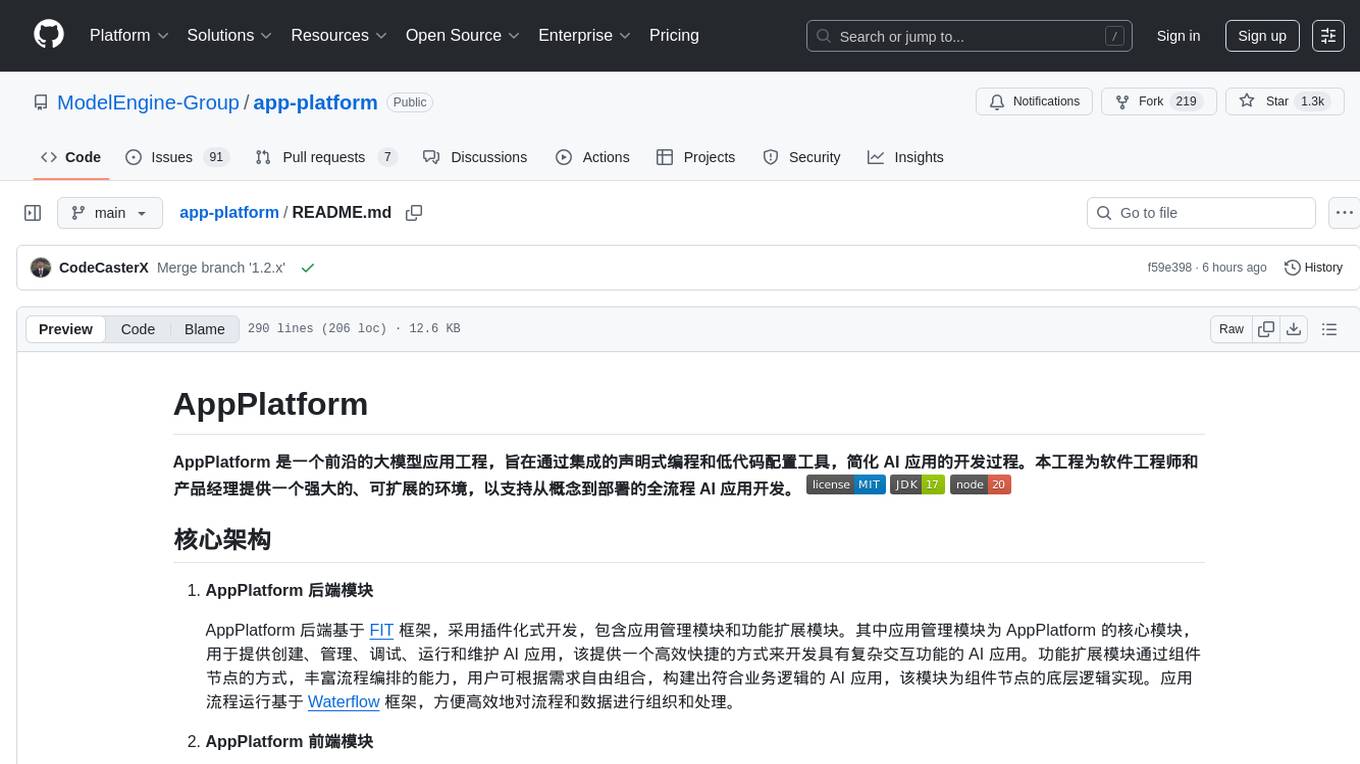
app-platform
AppPlatform is an advanced large-scale model application engineering aimed at simplifying the development process of AI applications through integrated declarative programming and low-code configuration tools. This project provides a powerful and scalable environment for software engineers and product managers to support the full-cycle development of AI applications from concept to deployment. The backend module is based on the FIT framework, utilizing a plugin-based development approach, including application management and feature extension modules. The frontend module is developed using React framework, focusing on core modules such as application development, application marketplace, intelligent forms, and plugin management. Key features include low-code graphical interface, powerful operators and scheduling platform, and sharing and collaboration capabilities. The project also provides detailed instructions for setting up and running both backend and frontend environments for development and testing.
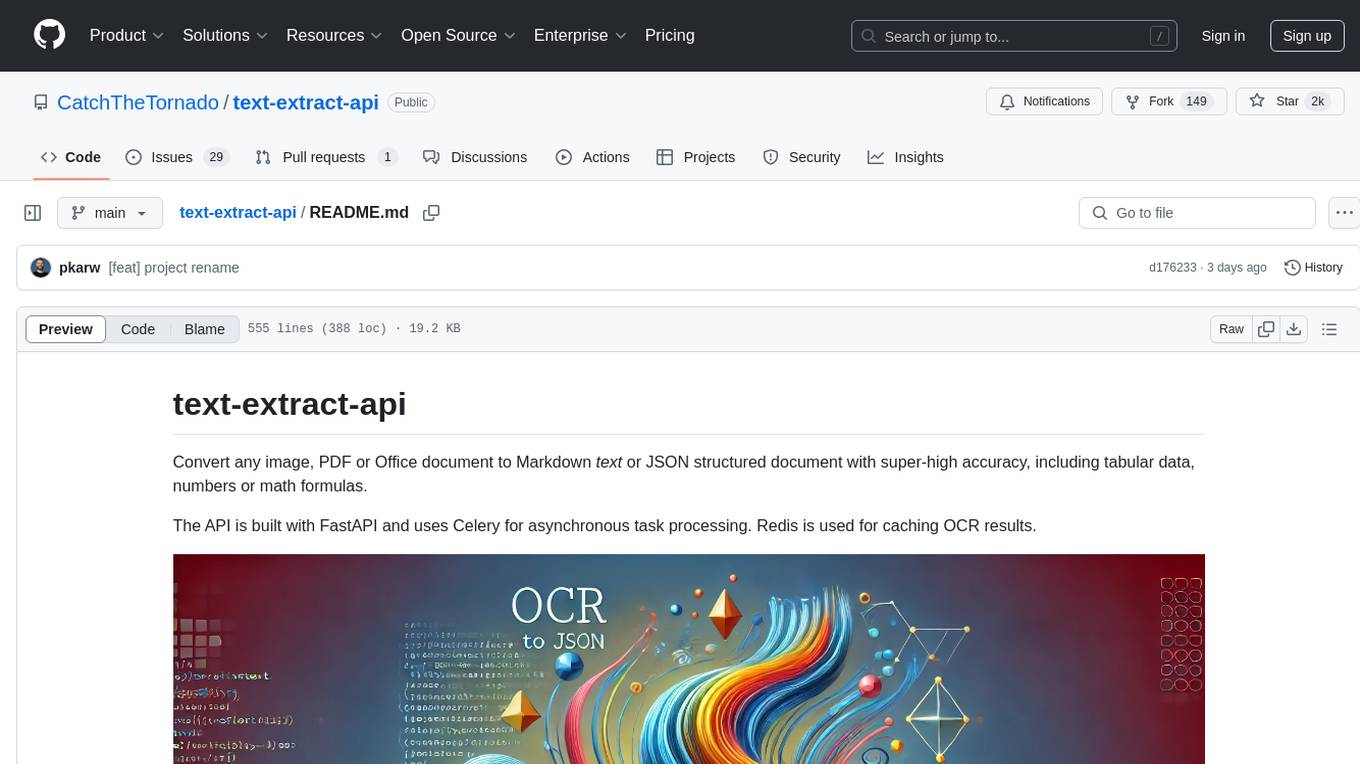
text-extract-api
The text-extract-api is a powerful tool that allows users to convert images, PDFs, or Office documents to Markdown text or JSON structured documents with high accuracy. It is built using FastAPI and utilizes Celery for asynchronous task processing, with Redis for caching OCR results. The tool provides features such as PDF/Office to Markdown and JSON conversion, improving OCR results with LLama, removing Personally Identifiable Information from documents, distributed queue processing, caching using Redis, switchable storage strategies, and a CLI tool for task management. Users can run the tool locally or on cloud services, with support for GPU processing. The tool also offers an online demo for testing purposes.

rlama
RLAMA is a powerful AI-driven question-answering tool that seamlessly integrates with local Ollama models. It enables users to create, manage, and interact with Retrieval-Augmented Generation (RAG) systems tailored to their documentation needs. RLAMA follows a clean architecture pattern with clear separation of concerns, focusing on lightweight and portable RAG capabilities with minimal dependencies. The tool processes documents, generates embeddings, stores RAG systems locally, and provides contextually-informed responses to user queries. Supported document formats include text, code, and various document types, with troubleshooting steps available for common issues like Ollama accessibility, text extraction problems, and relevance of answers.
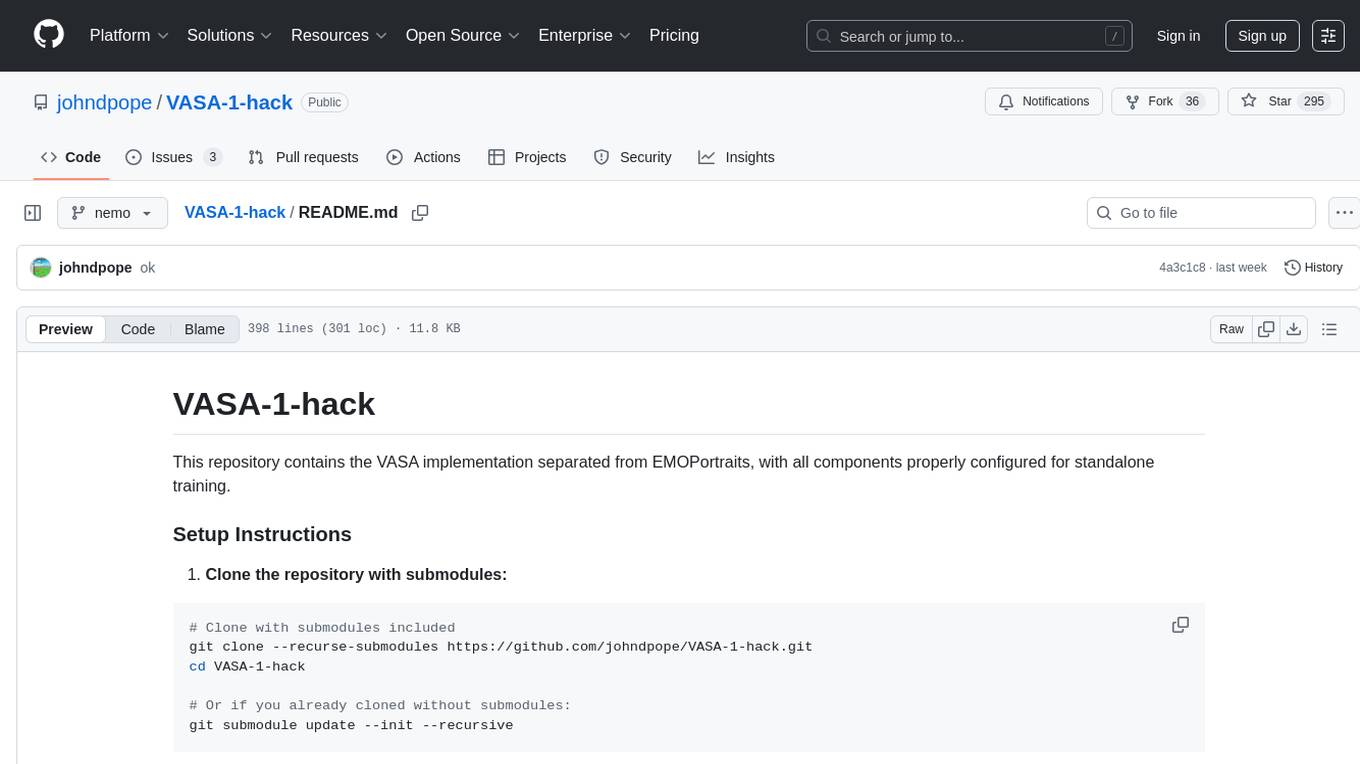
VASA-1-hack
VASA-1-hack is a repository containing the VASA implementation separated from EMOPortraits, with all components properly configured for standalone training. It provides detailed setup instructions, prerequisites, project structure, configuration details, running training modes, troubleshooting tips, monitoring training progress, development information, and acknowledgments. The repository aims to facilitate training volumetric avatar models with configurable parameters and logging levels for efficient debugging and testing.
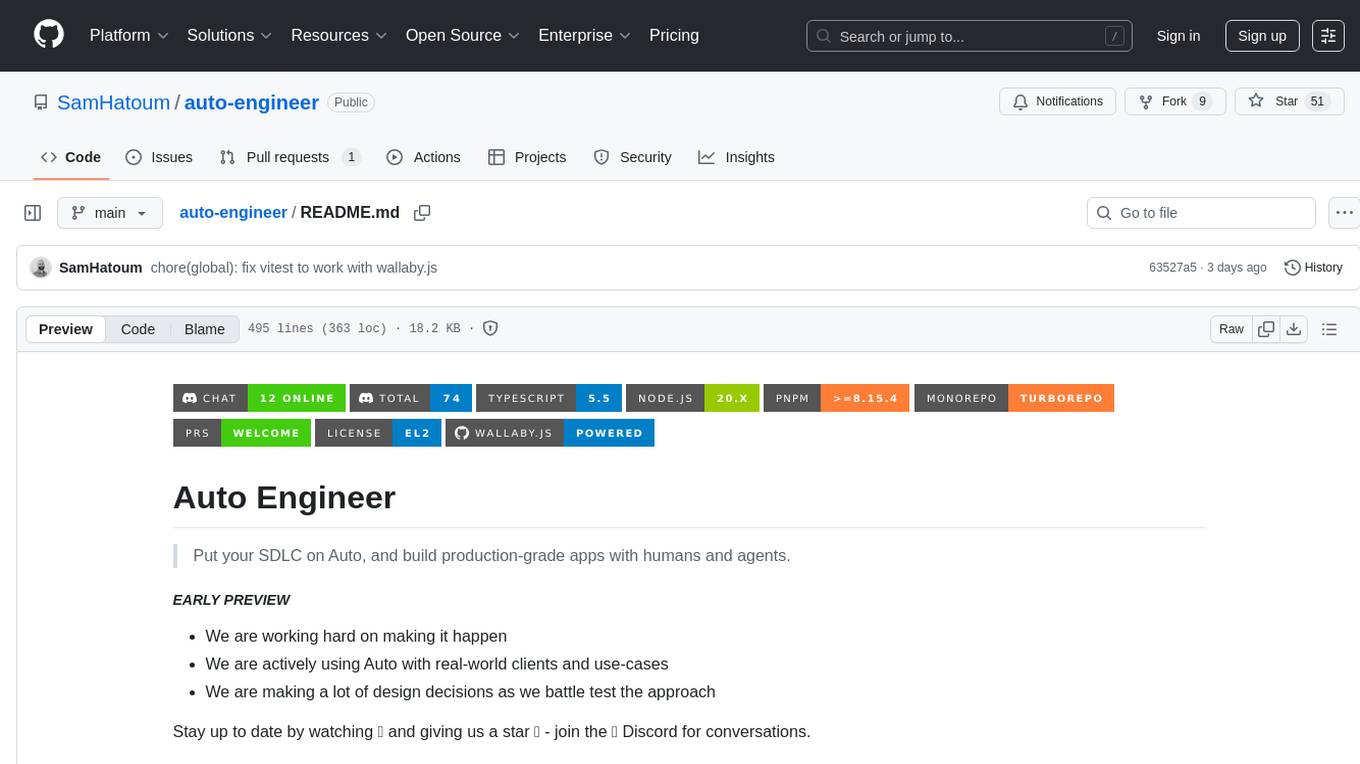
auto-engineer
Auto Engineer is a tool designed to automate the Software Development Life Cycle (SDLC) by building production-grade applications with a combination of human and AI agents. It offers a plugin-based architecture that allows users to install only the necessary functionality for their projects. The tool guides users through key stages including Flow Modeling, IA Generation, Deterministic Scaffolding, AI Coding & Testing Loop, and Comprehensive Quality Checks. Auto Engineer follows a command/event-driven architecture and provides a modular plugin system for specific functionalities. It supports TypeScript with strict typing throughout and includes a built-in message bus server with a web dashboard for monitoring commands and events.
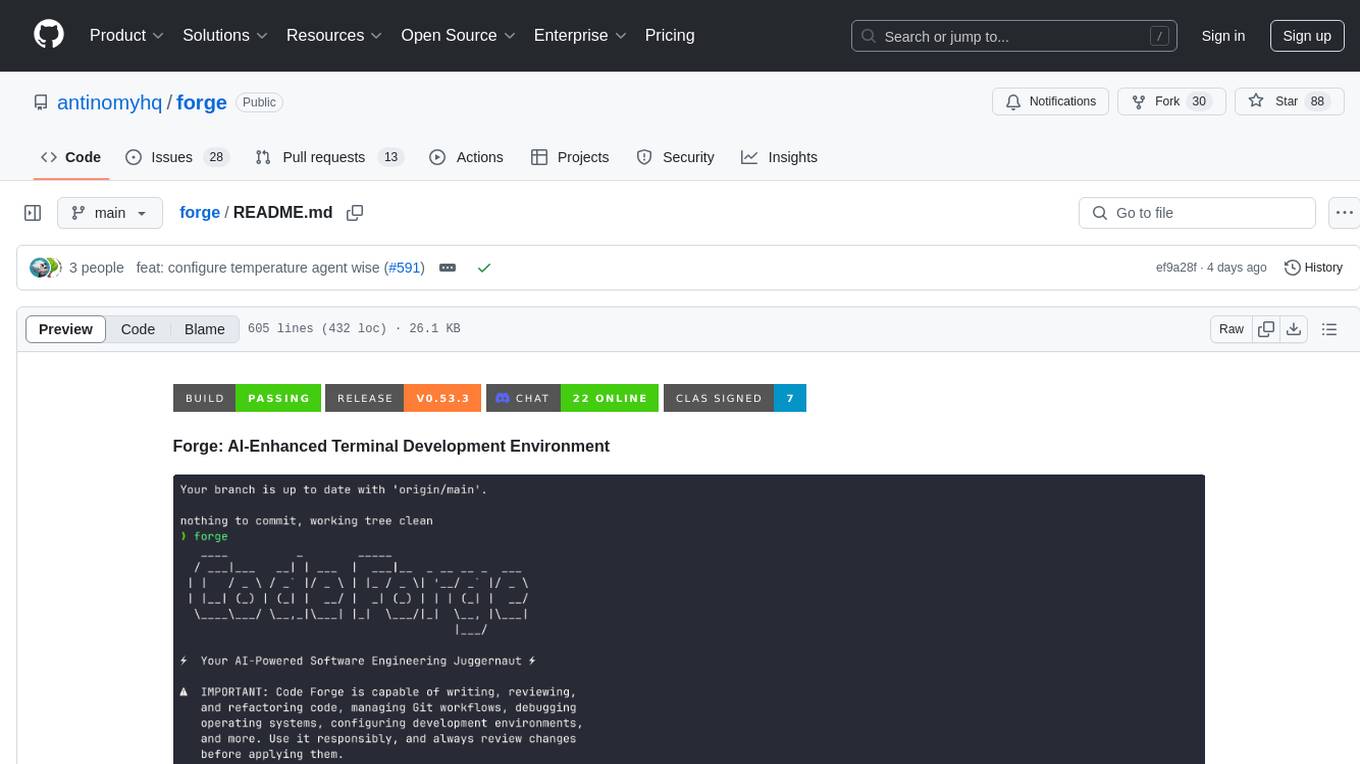
forge
Forge is a powerful open-source tool for building modern web applications. It provides a simple and intuitive interface for developers to quickly scaffold and deploy projects. With Forge, you can easily create custom components, manage dependencies, and streamline your development workflow. Whether you are a beginner or an experienced developer, Forge offers a flexible and efficient solution for your web development needs.
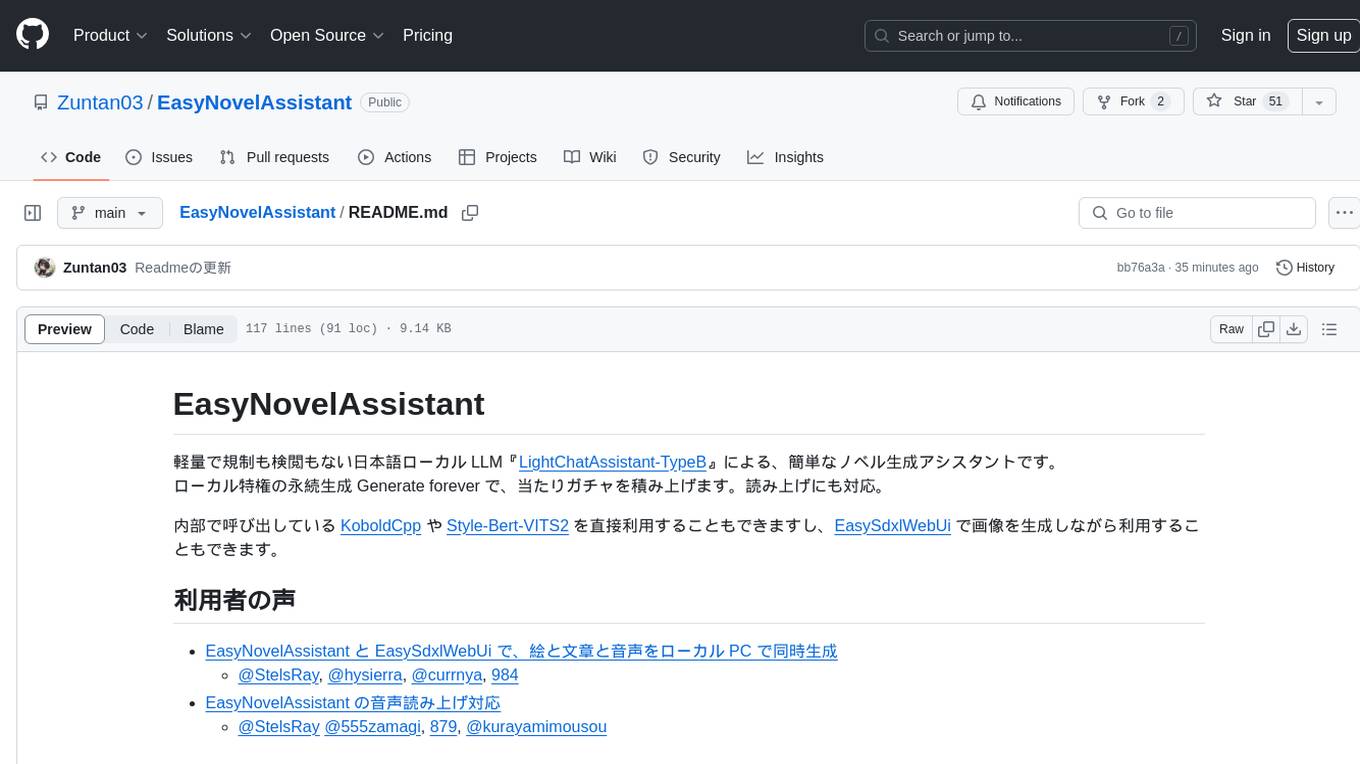
EasyNovelAssistant
EasyNovelAssistant is a simple novel generation assistant powered by a lightweight and uncensored Japanese local LLM 'LightChatAssistant-TypeB'. It allows for perpetual generation with 'Generate forever' feature, stacking up lucky gacha draws. It also supports text-to-speech. Users can directly utilize KoboldCpp and Style-Bert-VITS2 internally or use EasySdxlWebUi to generate images while using the tool. The tool is designed for local novel generation with a focus on ease of use and flexibility.
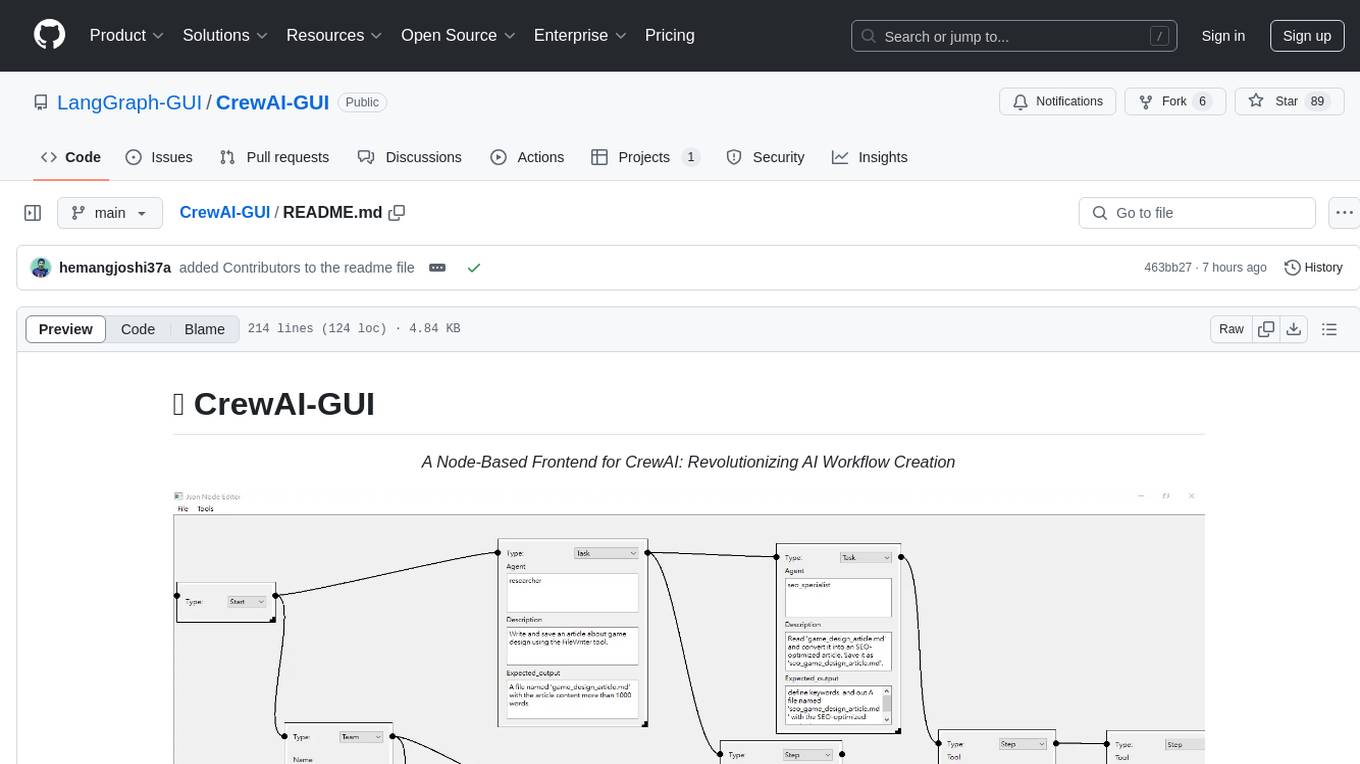
CrewAI-GUI
CrewAI-GUI is a Node-Based Frontend tool designed to revolutionize AI workflow creation. It empowers users to design complex AI agent interactions through an intuitive drag-and-drop interface, export designs to JSON for modularity and reusability, and supports both GPT-4 API and Ollama for flexible AI backend. The tool ensures cross-platform compatibility, allowing users to create AI workflows on Windows, Linux, or macOS efficiently.
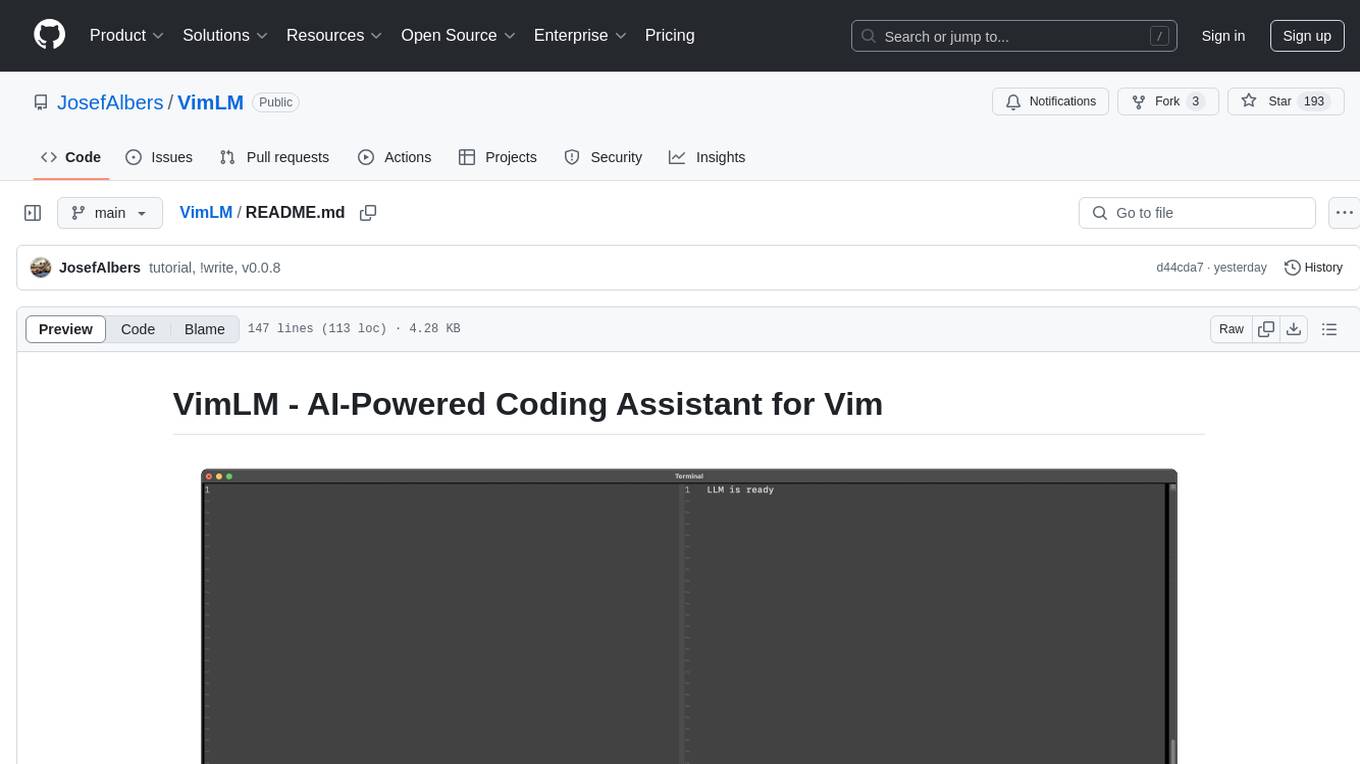
VimLM
VimLM is an AI-powered coding assistant for Vim that integrates AI for code generation, refactoring, and documentation directly into your Vim workflow. It offers native Vim integration with split-window responses and intuitive keybindings, offline first execution with MLX-compatible models, contextual awareness with seamless integration with codebase and external resources, conversational workflow for iterating on responses, project scaffolding for generating and deploying code blocks, and extensibility for creating custom LLM workflows with command chains.
wealth-tracker
Wealth Tracker is a personal finance management tool designed to help users track their income, expenses, and investments in one place. With intuitive features and customizable categories, users can easily monitor their financial health and make informed decisions. The tool provides detailed reports and visualizations to analyze spending patterns and set financial goals. Whether you are budgeting, saving for a big purchase, or planning for retirement, Wealth Tracker offers a comprehensive solution to manage your money effectively.
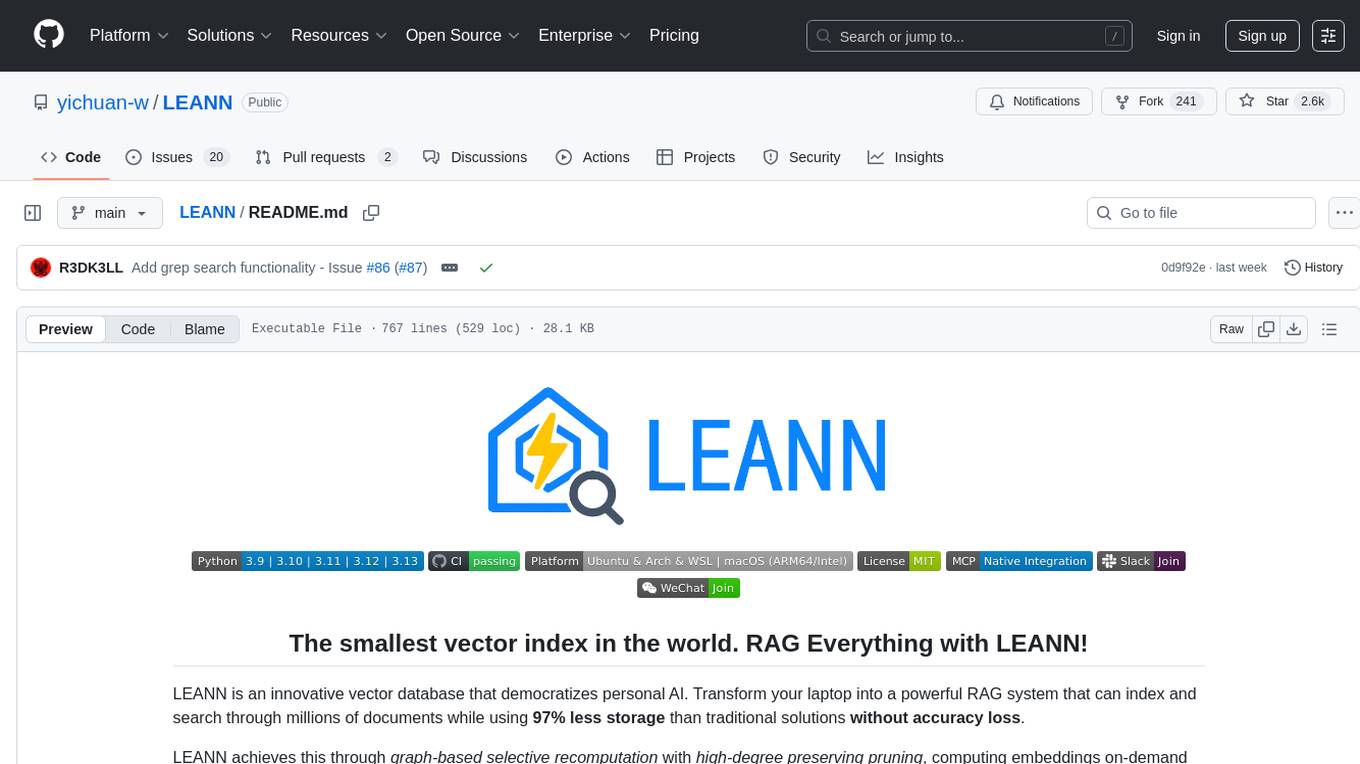
LEANN
LEANN is an innovative vector database that democratizes personal AI, transforming your laptop into a powerful RAG system that can index and search through millions of documents using 97% less storage than traditional solutions without accuracy loss. It achieves this through graph-based selective recomputation and high-degree preserving pruning, computing embeddings on-demand instead of storing them all. LEANN allows semantic search of file system, emails, browser history, chat history, codebase, or external knowledge bases on your laptop with zero cloud costs and complete privacy. It is a drop-in semantic search MCP service fully compatible with Claude Code, enabling intelligent retrieval without changing your workflow.
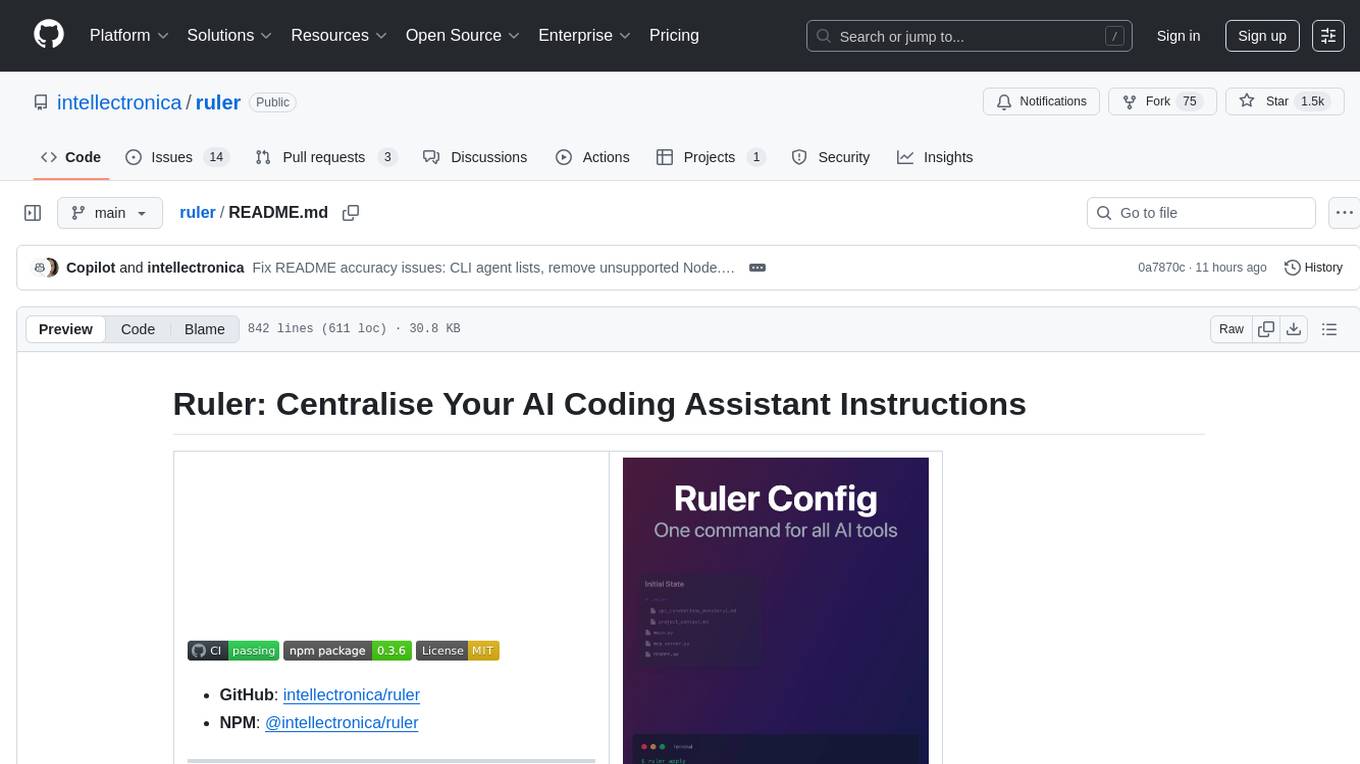
ruler
Ruler is a tool designed to centralize AI coding assistant instructions, providing a single source of truth for managing instructions across multiple AI coding tools. It helps in avoiding inconsistent guidance, duplicated effort, context drift, onboarding friction, and complex project structures by automatically distributing instructions to the right configuration files. With support for nested rule loading, Ruler can handle complex project structures with context-specific instructions for different components. It offers features like centralised rule management, nested rule loading, automatic distribution, targeted agent configuration, MCP server propagation, .gitignore automation, and a simple CLI for easy configuration management.
For similar tasks

video2blog
video2blog is an open-source project aimed at converting videos into textual notes. The tool follows a process of extracting video information using yt-dlp, downloading the video, downloading subtitles if available, translating subtitles if not in Chinese, generating Chinese subtitles using whisper if no subtitles exist, converting subtitles to articles using gemini, and manually inserting images from the video into the article. The tool provides a solution for creating blog content from video resources, enhancing accessibility and content creation efficiency.
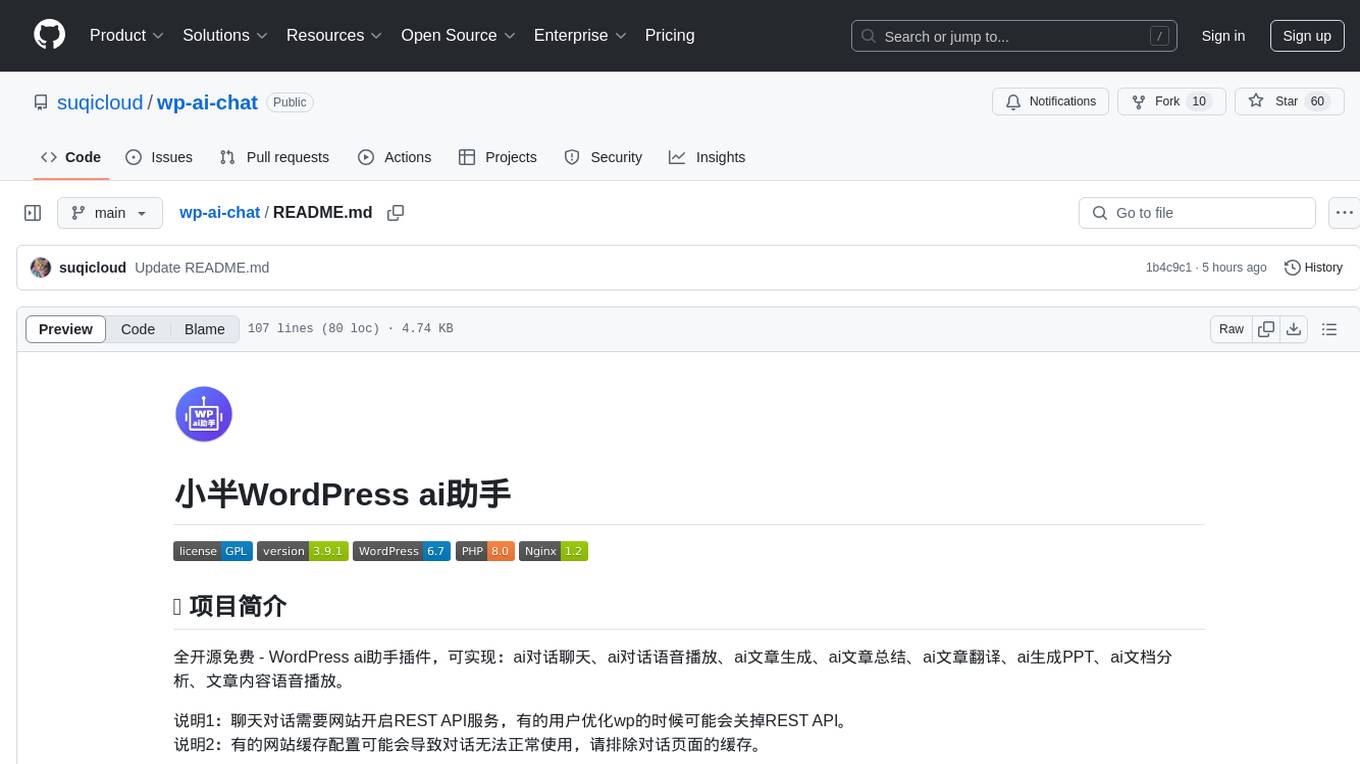
wp-ai-chat
The 'wp-ai-chat' repository is an open-source and free WordPress AI assistant plugin that enables various AI functionalities such as AI chat conversations, AI voice playback, AI article generation, AI article summarization, AI article translation, AI PPT generation, AI document analysis, and article content voice playback. It supports integration with multiple AI text interfaces and intelligent applications from platforms like Alibaba, Tencent, and ByteDance. Users can generate articles, summarize articles, translate articles, play article content via text-to-speech services, and customize AI models and prompts. The plugin requires WordPress 6.7.1 and PHP 8.0, and provides a front-end chat interface for logged-in users.
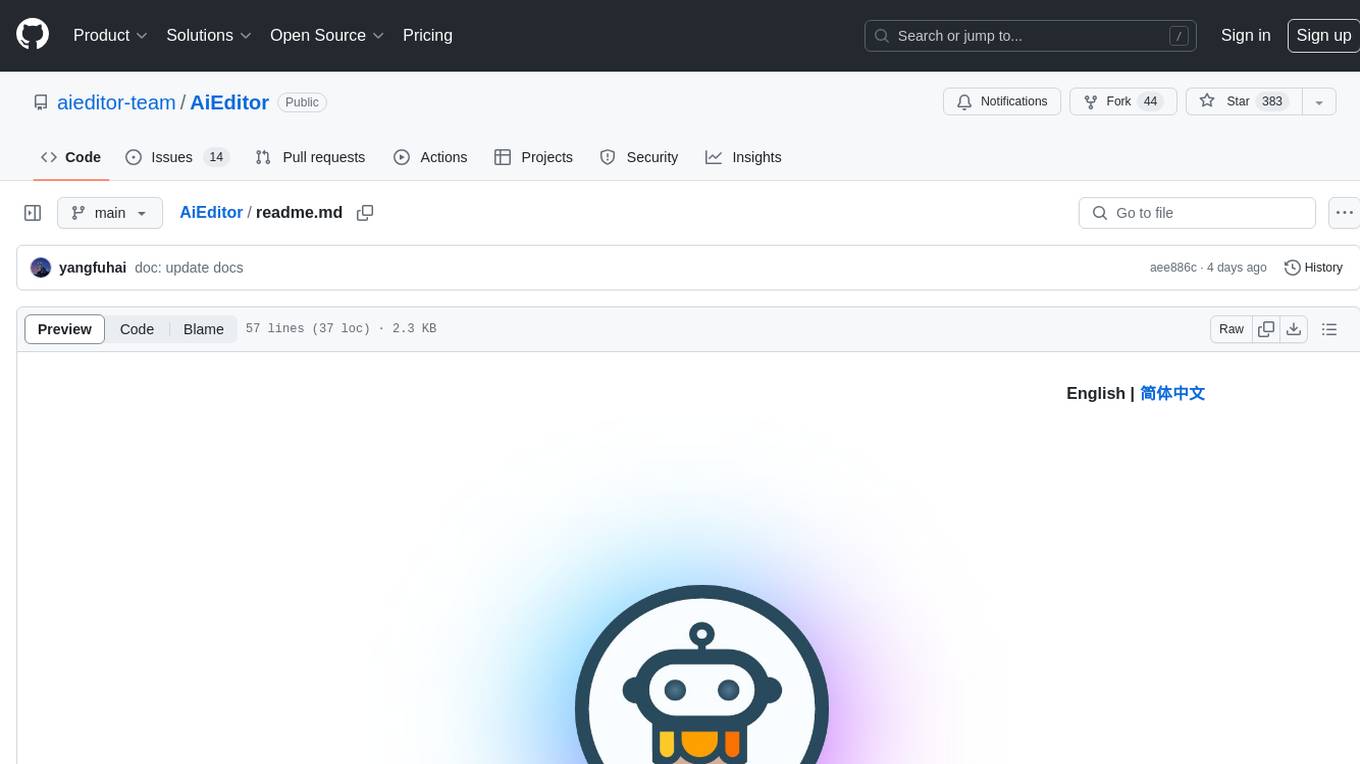
AiEditor
AiEditor is a next-generation rich text editor for AI, based on Web Component and supporting various front-end frameworks. It offers two themes, light and dark, along with flexible configuration for developing text editing applications. The editor includes features for basic text formatting, enhancements like undo/redo and format painter, support for attachments like images and videos, code-related functionalities, table manipulation, Markdown support, AI-related features such as continuation and optimization, and more. Planned improvements include collaboration, automated testing, AI picture insertion and drawing, enhanced paste features, WORD and PDF export, Notion-like operations, and integration with ChatGPT.
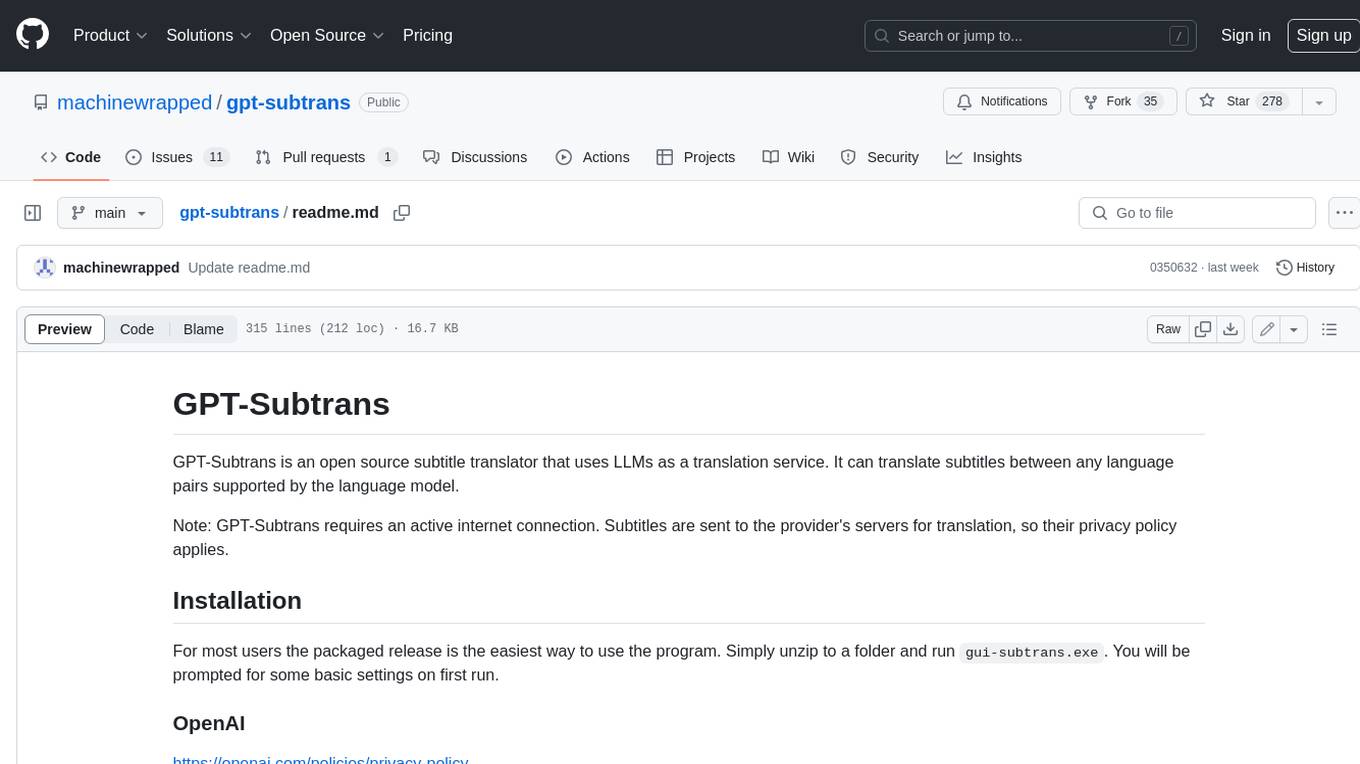
gpt-subtrans
GPT-Subtrans is an open-source subtitle translator that utilizes large language models (LLMs) as translation services. It supports translation between any language pairs that the language model supports. Note that GPT-Subtrans requires an active internet connection, as subtitles are sent to the provider's servers for translation, and their privacy policy applies.
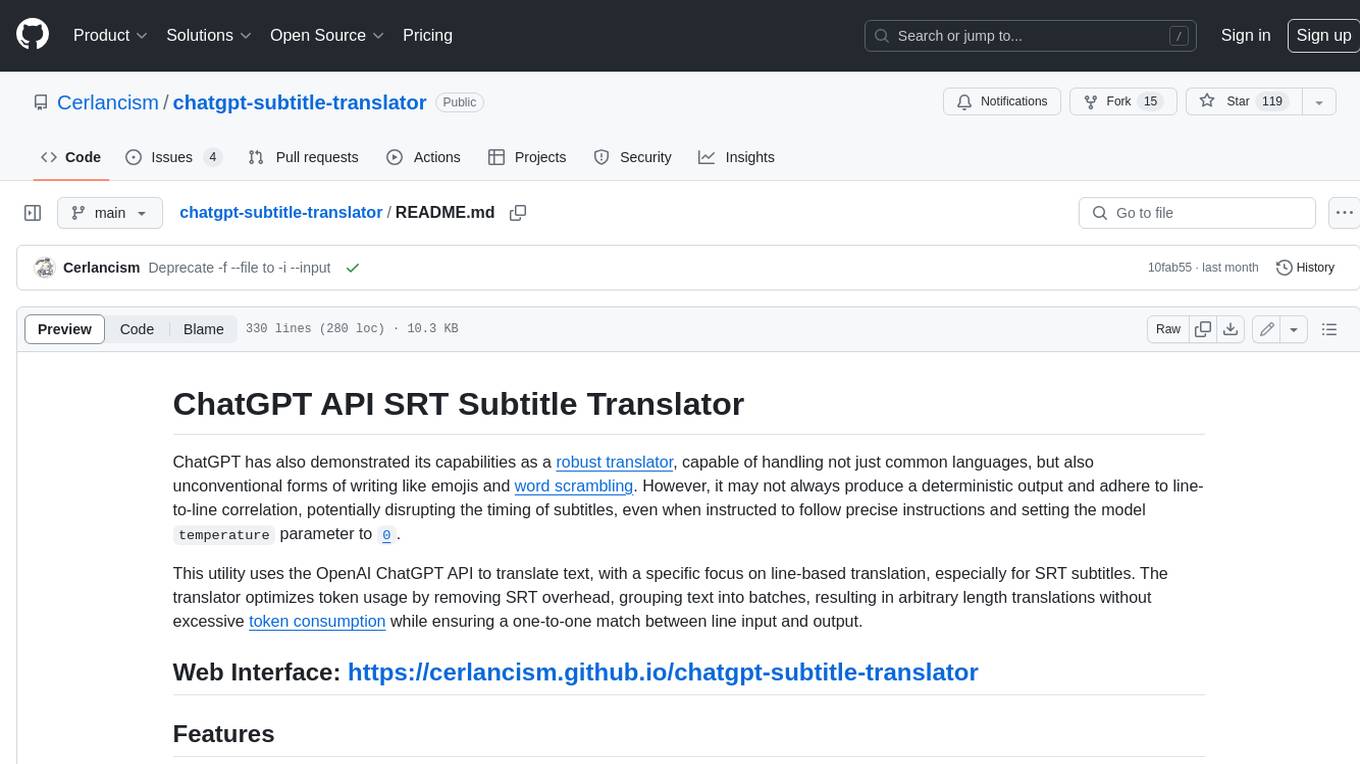
chatgpt-subtitle-translator
This tool utilizes the OpenAI ChatGPT API to translate text, with a focus on line-based translation, particularly for SRT subtitles. It optimizes token usage by removing SRT overhead and grouping text into batches, allowing for arbitrary length translations without excessive token consumption while maintaining a one-to-one match between line input and output.
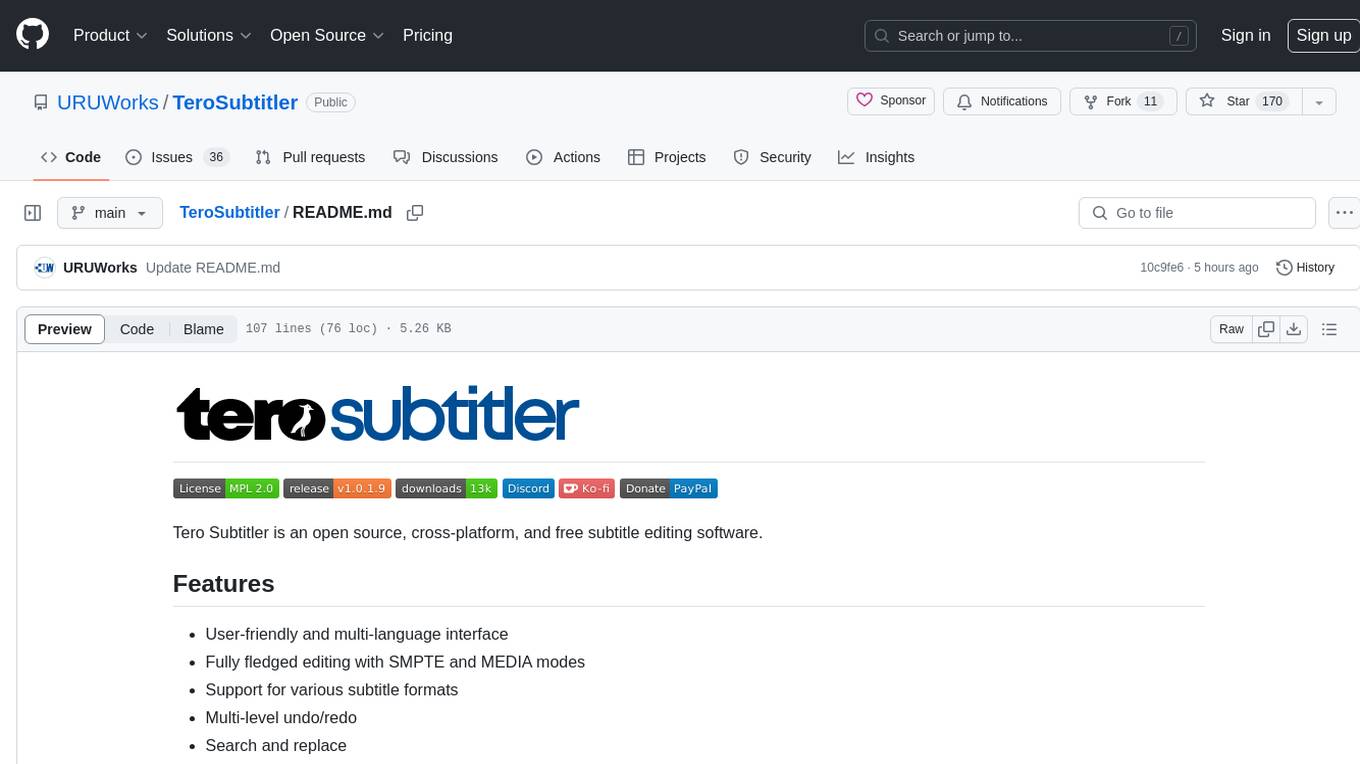
TeroSubtitler
Tero Subtitler is an open source, cross-platform, and free subtitle editing software with a user-friendly interface. It offers fully fledged editing with SMPTE and MEDIA modes, support for various subtitle formats, multi-level undo/redo, search and replace, auto-backup, source and transcription modes, translation memory, audiovisual preview, timeline with waveform visualizer, manipulation tools, formatting options, quality control features, translation and transcription capabilities, validation tools, automation for correcting errors, and more. It also includes features like exporting subtitles to MP3, importing/exporting Blu-ray SUP format, generating blank video, generating video with hardcoded subtitles, video dubbing, and more. The tool utilizes powerful multimedia playback engines like mpv, advanced audio/video manipulation tools like FFmpeg, tools for automatic transcription like whisper.cpp/Faster-Whisper, auto-translation API like Google Translate, and ElevenLabs TTS for video dubbing.
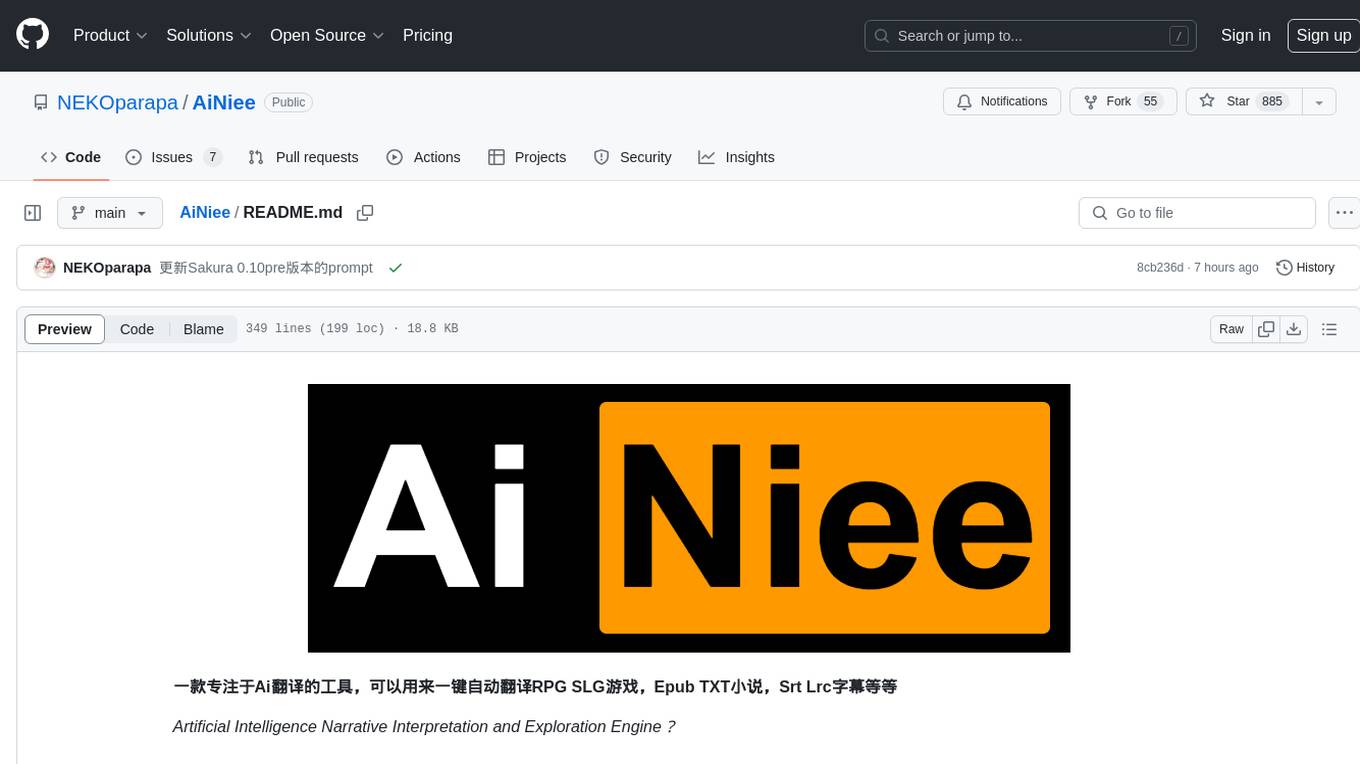
AiNiee
AiNiee is a tool focused on AI translation, capable of automatically translating RPG SLG games, Epub TXT novels, Srt Lrc subtitles, and more. It provides features for configuring AI platforms, proxies, and translation settings. Users can utilize this tool for translating game scripts, novels, and subtitles efficiently. The tool supports multiple AI platforms and offers tutorials for beginners. It also includes functionalities for extracting and translating game text, with options for customizing translation projects and managing translation tasks effectively.
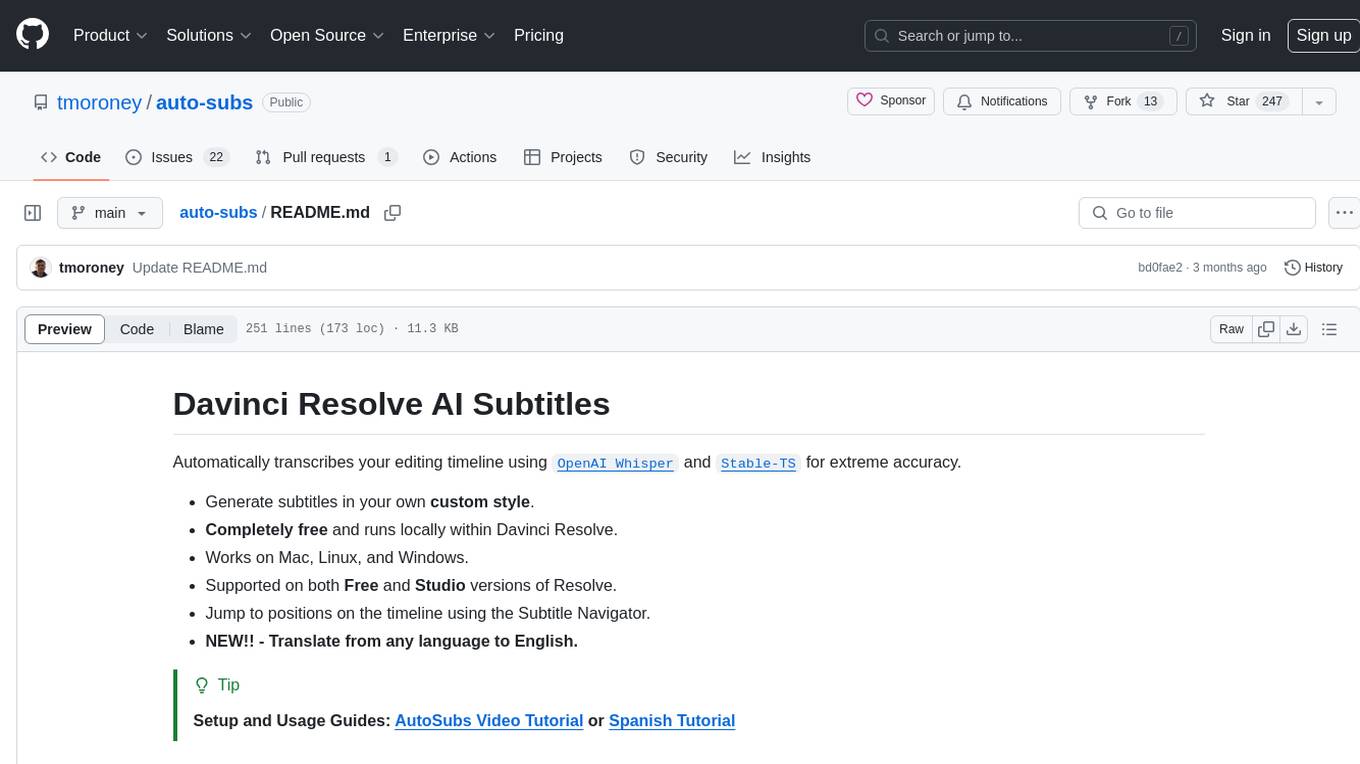
auto-subs
Auto-subs is a tool designed to automatically transcribe editing timelines using OpenAI Whisper and Stable-TS for extreme accuracy. It generates subtitles in a custom style, is completely free, and runs locally within Davinci Resolve. It works on Mac, Linux, and Windows, supporting both Free and Studio versions of Resolve. Users can jump to positions on the timeline using the Subtitle Navigator and translate from any language to English. The tool provides a user-friendly interface for creating and customizing subtitles for video content.
For similar jobs
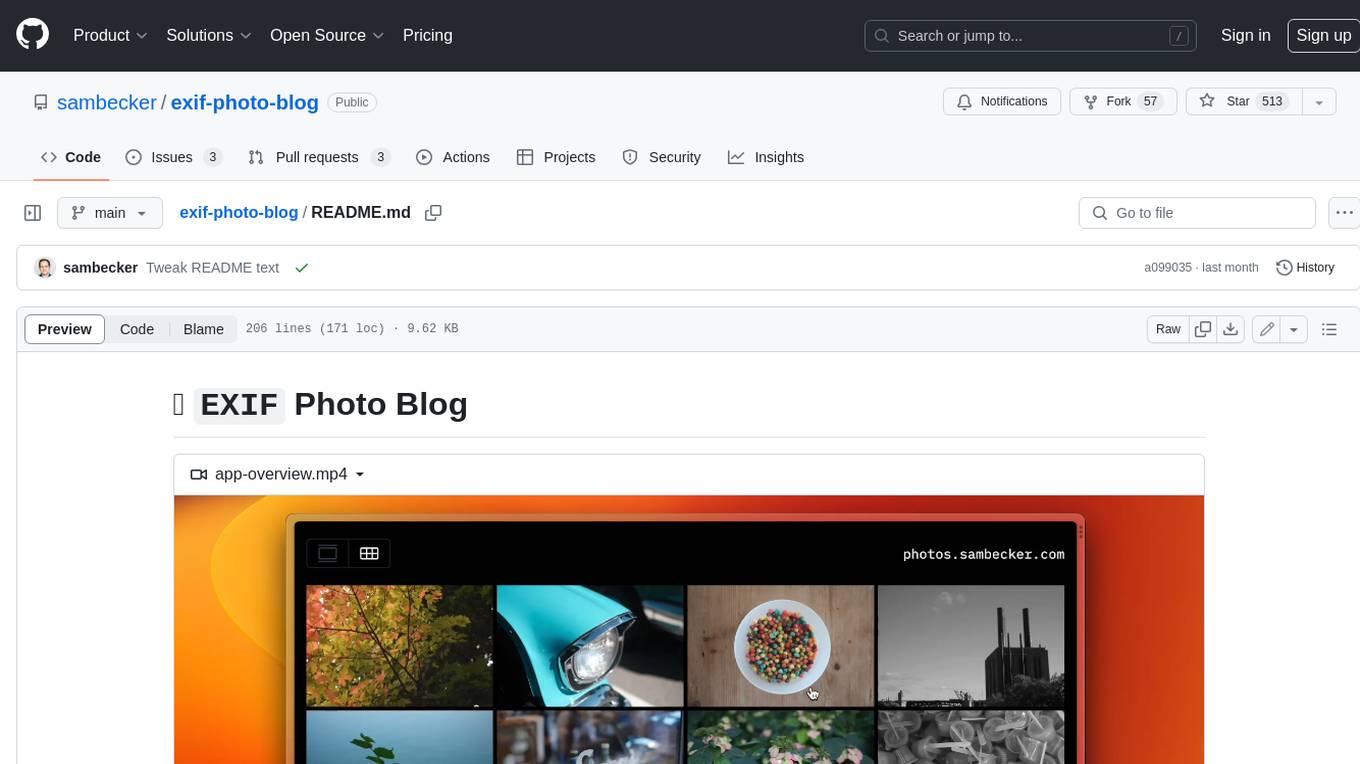
exif-photo-blog
EXIF Photo Blog is a full-stack photo blog application built with Next.js, Vercel, and Postgres. It features built-in authentication, photo upload with EXIF extraction, photo organization by tag, infinite scroll, light/dark mode, automatic OG image generation, a CMD-K menu with photo search, experimental support for AI-generated descriptions, and support for Fujifilm simulations. The application is easy to deploy to Vercel with just a few clicks and can be customized with a variety of environment variables.
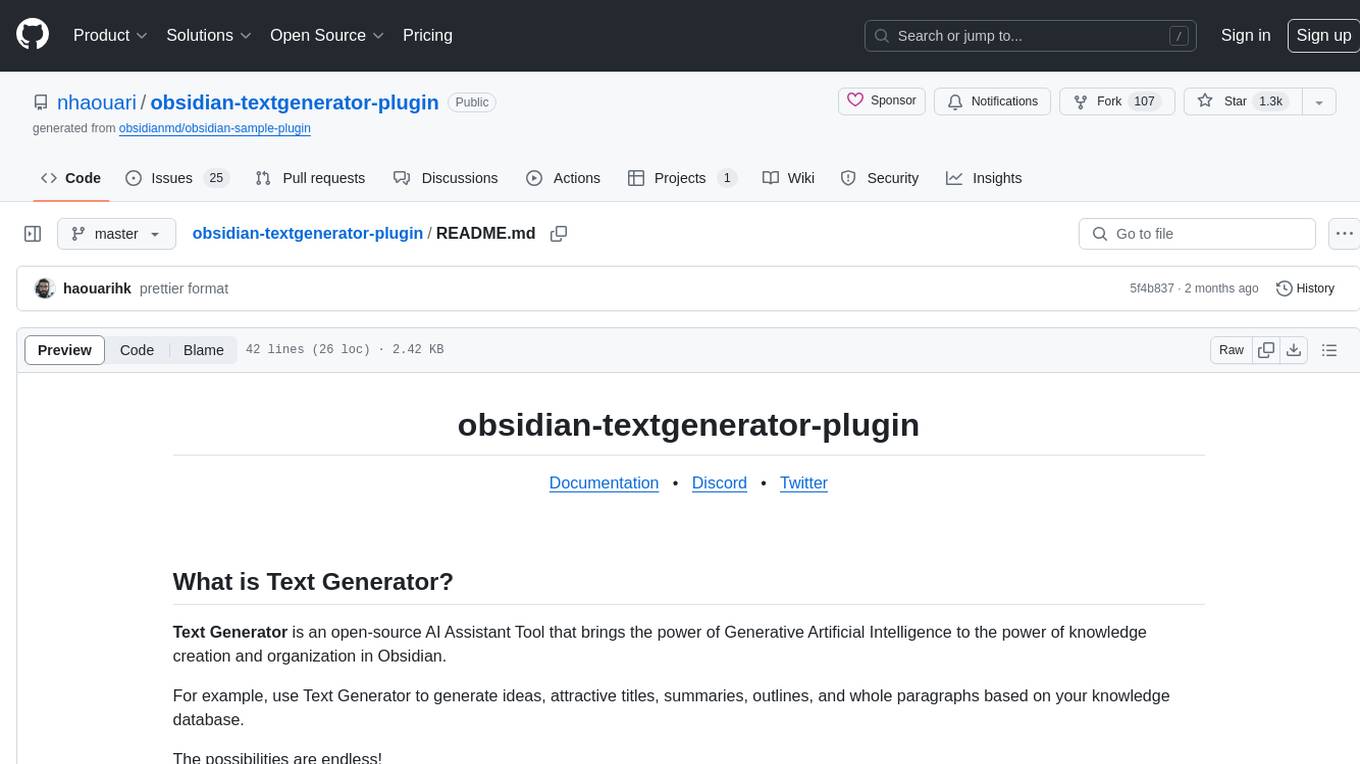
obsidian-textgenerator-plugin
Text Generator is an open-source AI Assistant Tool that leverages Generative Artificial Intelligence to enhance knowledge creation and organization in Obsidian. It allows users to generate ideas, titles, summaries, outlines, and paragraphs based on their knowledge database, offering endless possibilities. The plugin is free and open source, compatible with Obsidian for a powerful Personal Knowledge Management system. It provides flexible prompts, template engine for repetitive tasks, community templates for shared use cases, and highly flexible configuration with services like Google Generative AI, OpenAI, and HuggingFace.

video2blog
video2blog is an open-source project aimed at converting videos into textual notes. The tool follows a process of extracting video information using yt-dlp, downloading the video, downloading subtitles if available, translating subtitles if not in Chinese, generating Chinese subtitles using whisper if no subtitles exist, converting subtitles to articles using gemini, and manually inserting images from the video into the article. The tool provides a solution for creating blog content from video resources, enhancing accessibility and content creation efficiency.
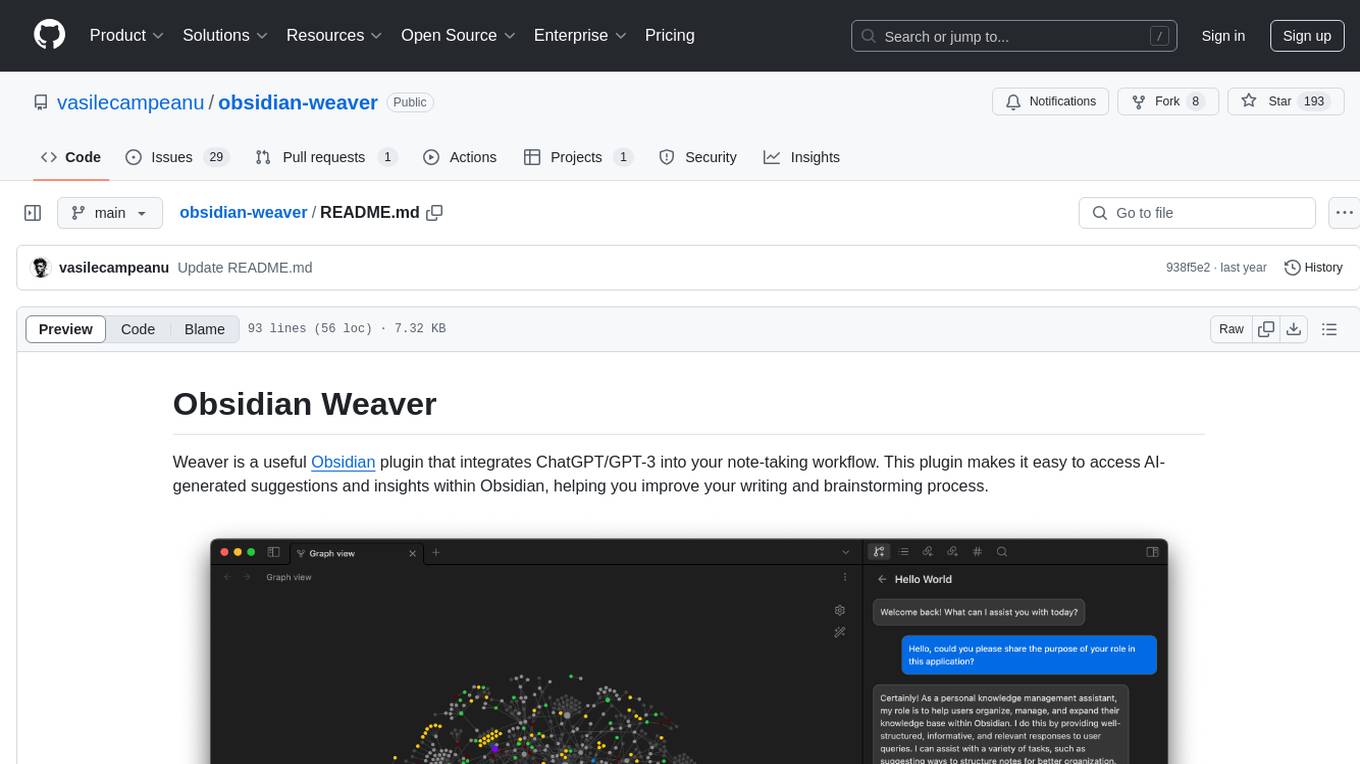
obsidian-weaver
Obsidian Weaver is a plugin that integrates ChatGPT/GPT-3 into the note-taking workflow of Obsidian. It allows users to easily access AI-generated suggestions and insights within Obsidian, enhancing the writing and brainstorming process. The plugin respects Obsidian's philosophy of storing notes locally, ensuring data security and privacy. Weaver offers features like creating new chat sessions with the AI assistant and receiving instant responses, all within the Obsidian environment. It provides a seamless integration with Obsidian's interface, making the writing process efficient and helping users stay focused. The plugin is constantly being improved with new features and updates to enhance the note-taking experience.
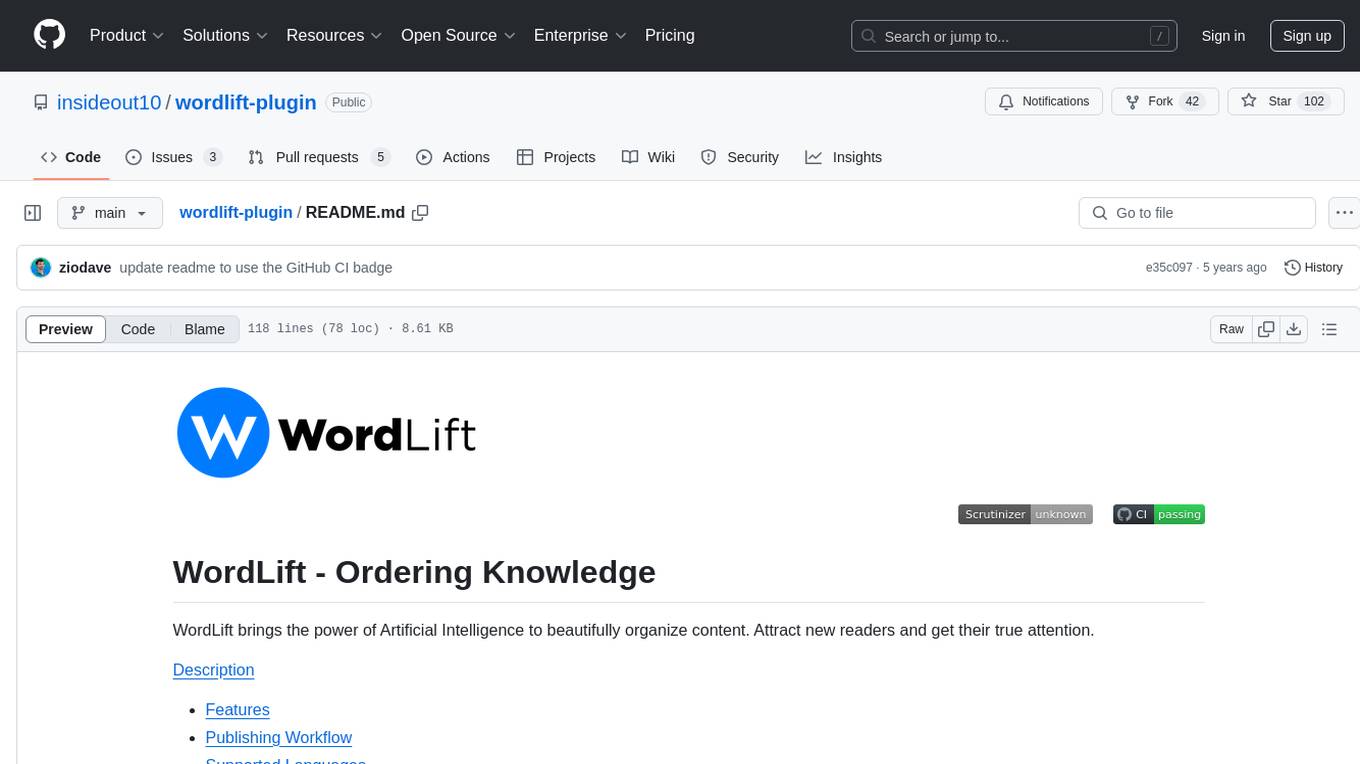
wordlift-plugin
WordLift is a plugin that helps online content creators organize posts and pages by adding facts, links, and media to build beautifully structured websites for both humans and search engines. It allows users to create, own, and publish their own knowledge graph, and publishes content as Linked Open Data following Tim Berners-Lee's Linked Data Principles. The plugin supports writers by providing trustworthy and contextual facts, enriching content with images, links, and interactive visualizations, keeping readers engaged with relevant content recommendations, and producing content compatible with schema.org markup for better indexing and display on search engines. It also offers features like creating a personal Wikipedia, publishing metadata to share and distribute content, and supporting content tagging for better SEO.
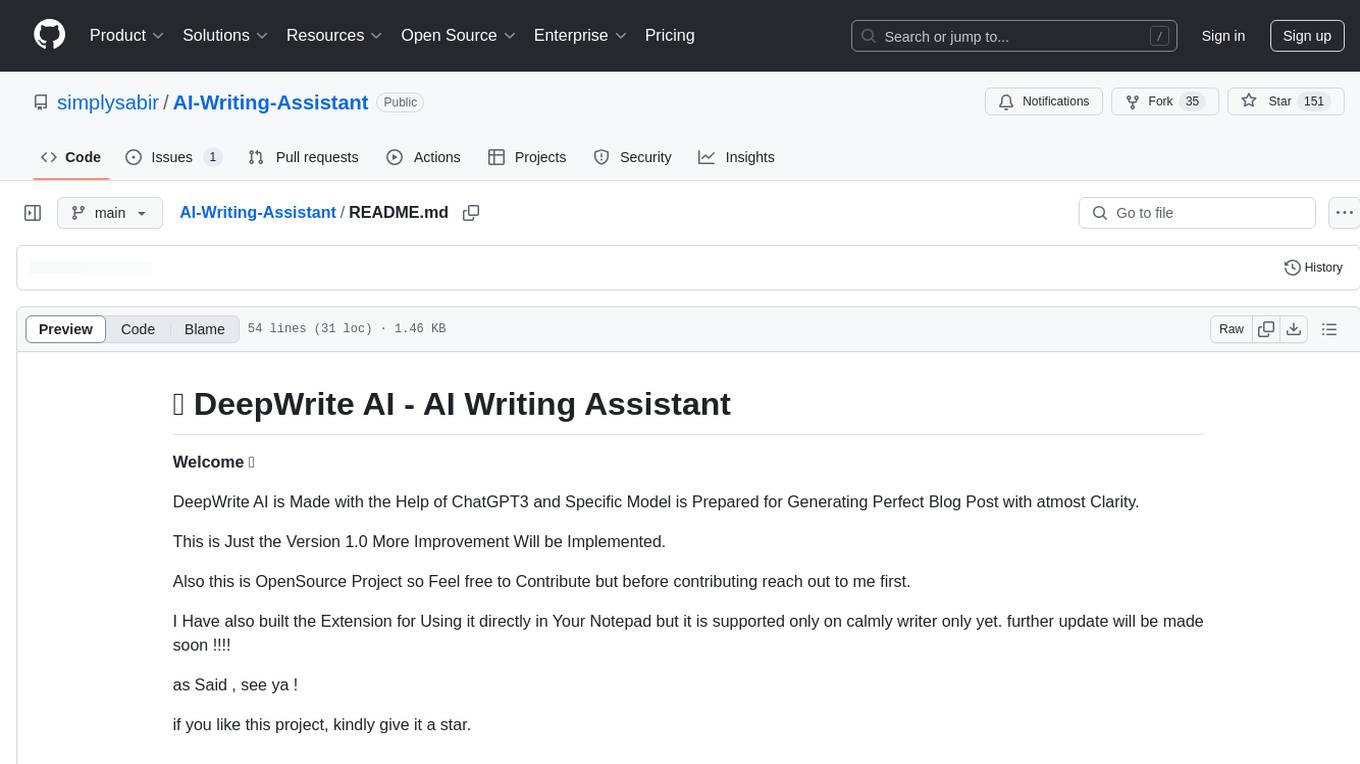
AI-Writing-Assistant
DeepWrite AI is an AI writing assistant tool created with the help of ChatGPT3. It is designed to generate perfect blog posts with utmost clarity. The tool is currently at version 1.0 with plans for further improvements. It is an open-source project, welcoming contributions. An extension has been developed for using the tool directly in Notepad, currently supported only on Calmly Writer. The tool requires installation and setup, utilizing technologies like React, Next, TailwindCSS, Node, and Express. For support, users can message the creator on Instagram. The creator, Sabir Khan, is an undergraduate student of Computer Science from Mumbai, known for frequently creating innovative projects.
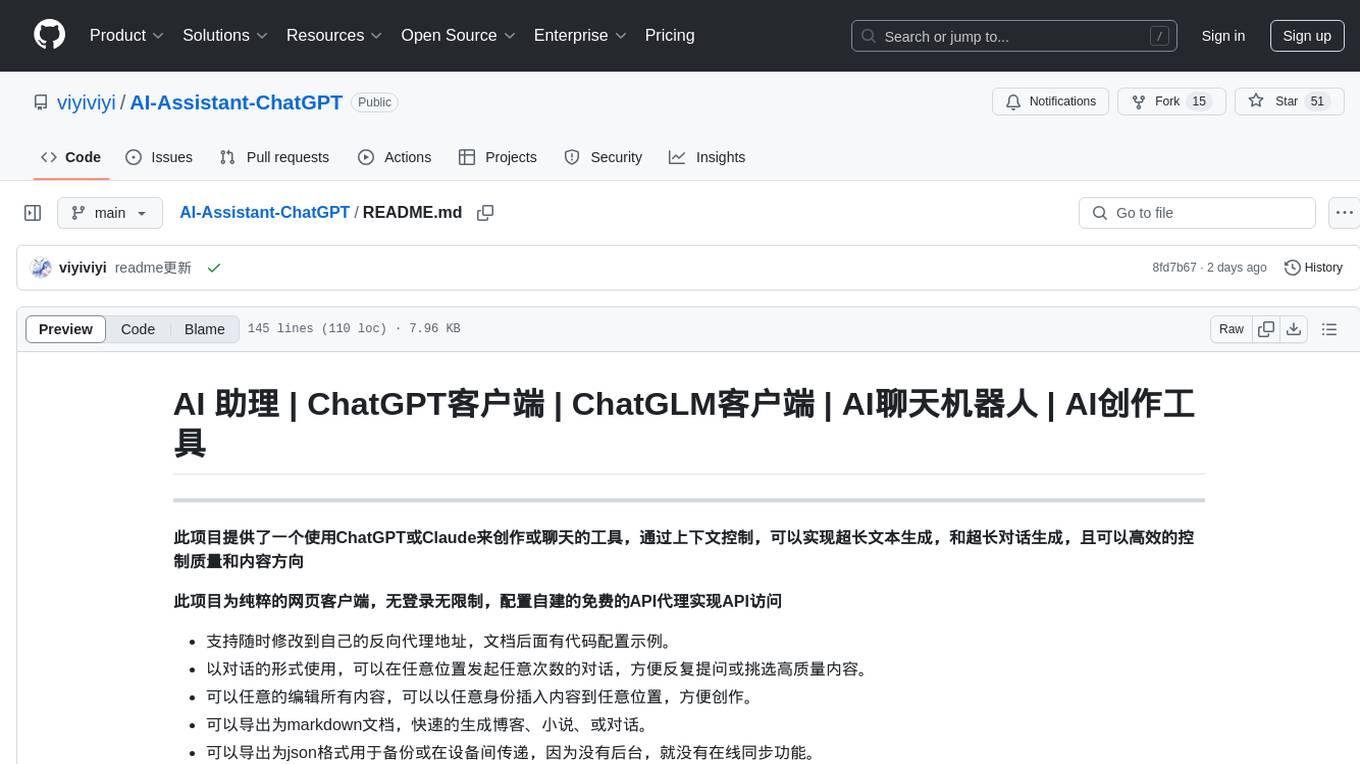
AI-Assistant-ChatGPT
AI Assistant ChatGPT is a web client tool that allows users to create or chat using ChatGPT or Claude. It enables generating long texts and conversations with efficient control over quality and content direction. The tool supports customization of reverse proxy address, conversation management, content editing, markdown document export, JSON backup, context customization, session-topic management, role customization, dynamic content navigation, and more. Users can access the tool directly at https://eaias.com or deploy it independently. It offers features for dialogue management, assistant configuration, session configuration, and more. The tool lacks data cloud storage and synchronization but provides guidelines for independent deployment. It is a frontend project that can be deployed using Cloudflare Pages and customized with backend modifications. The project is open-source under the MIT license.
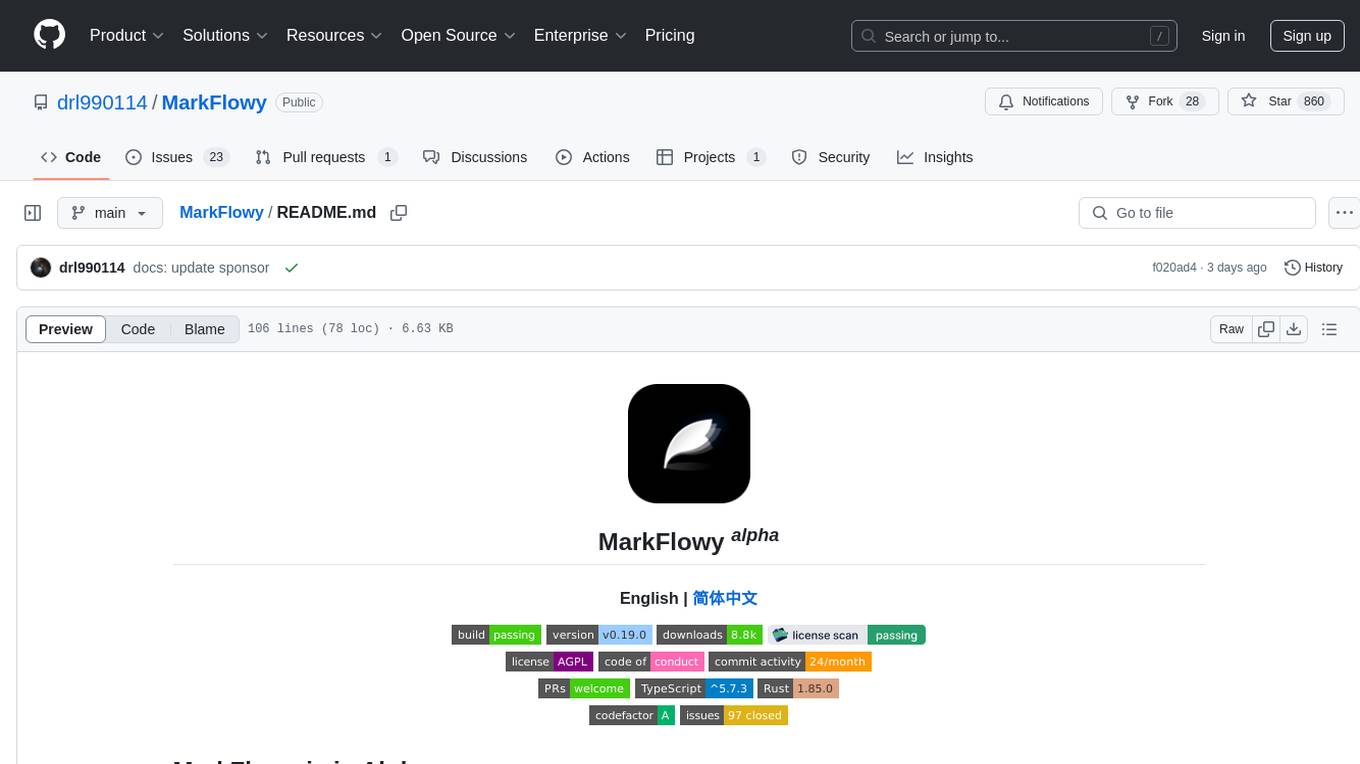
MarkFlowy
MarkFlowy is a lightweight and feature-rich Markdown editor with built-in AI capabilities. It supports one-click export of conversations, translation of articles, and obtaining article abstracts. Users can leverage large AI models like DeepSeek and Chatgpt as intelligent assistants. The editor provides high availability with multiple editing modes and custom themes. Available for Linux, macOS, and Windows, MarkFlowy aims to offer an efficient, beautiful, and data-safe Markdown editing experience for users.
